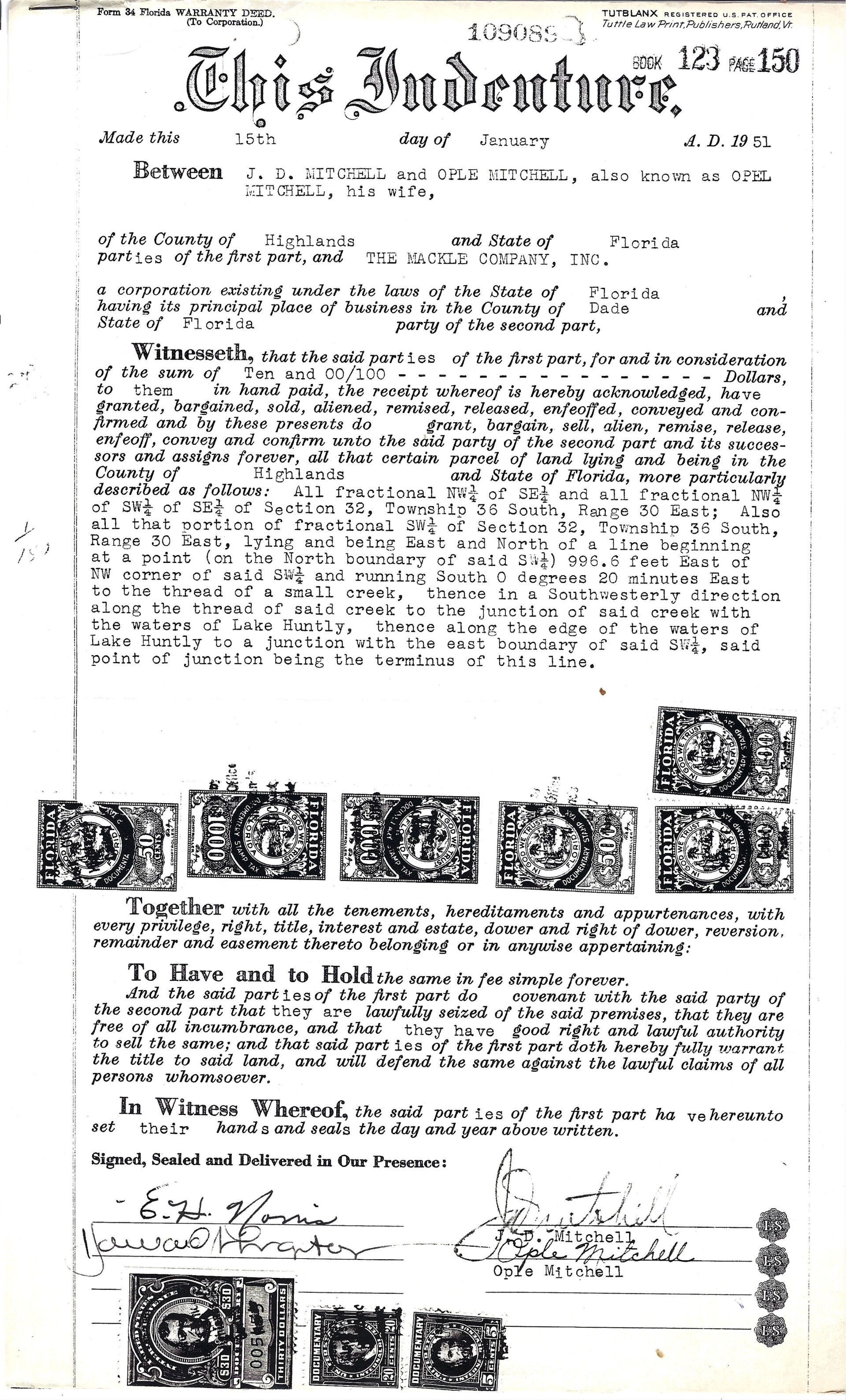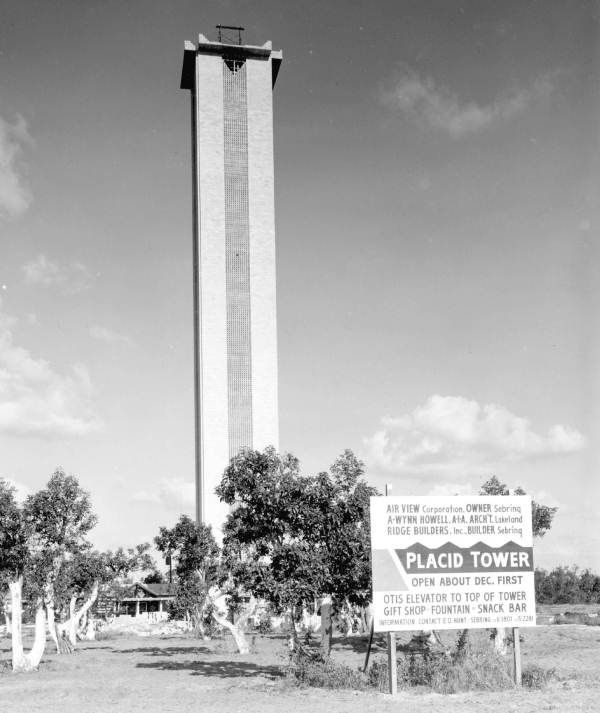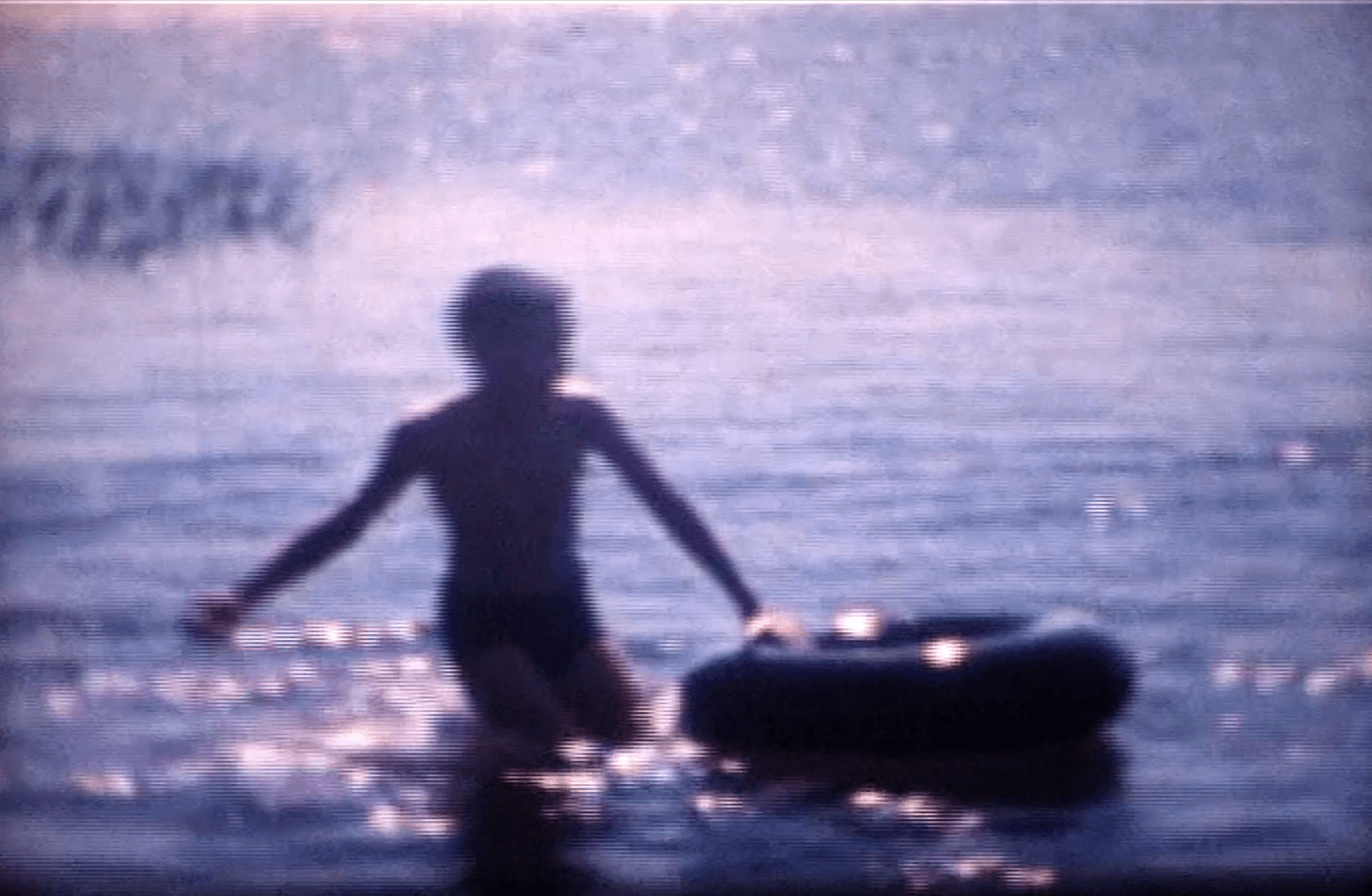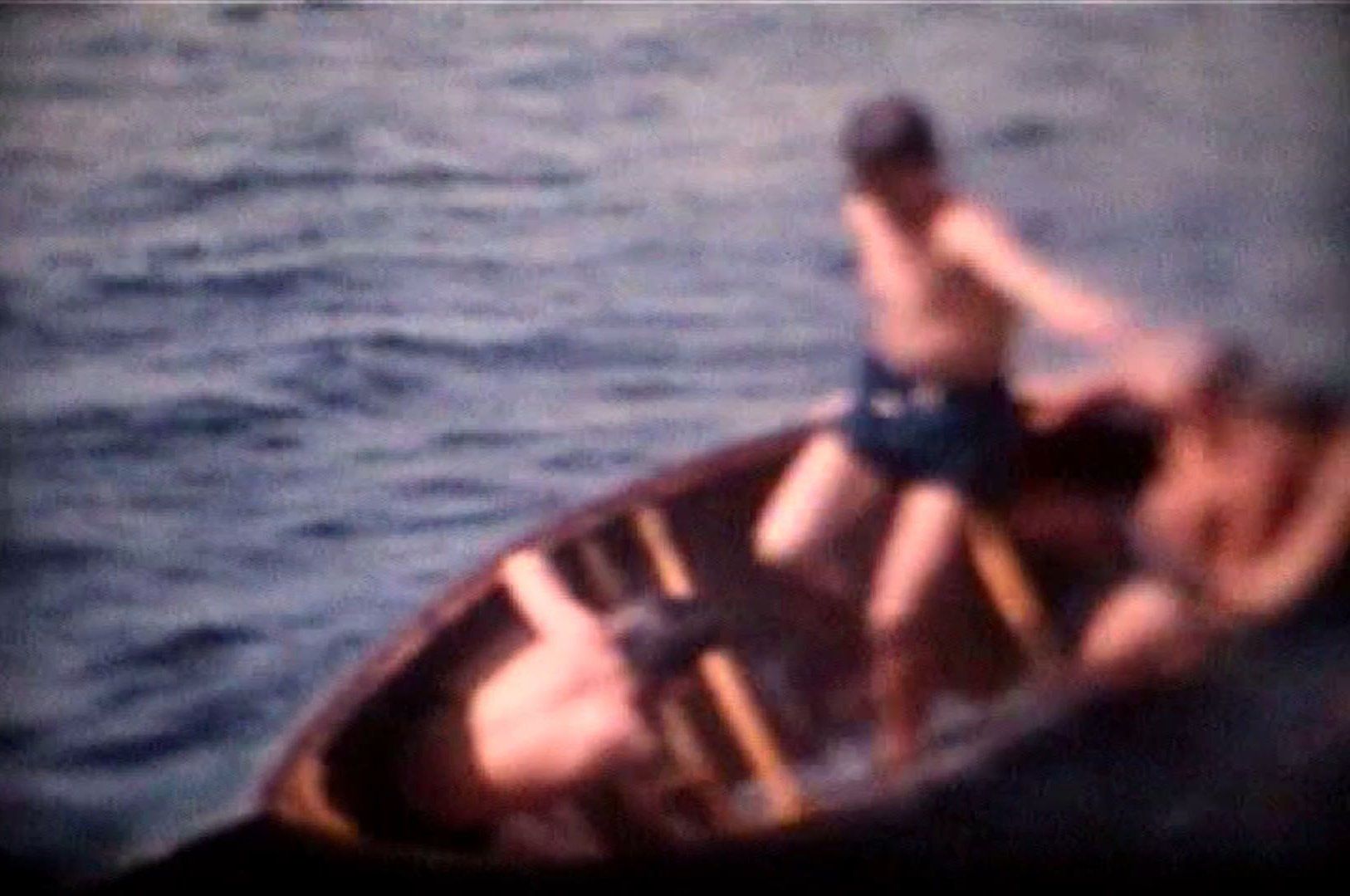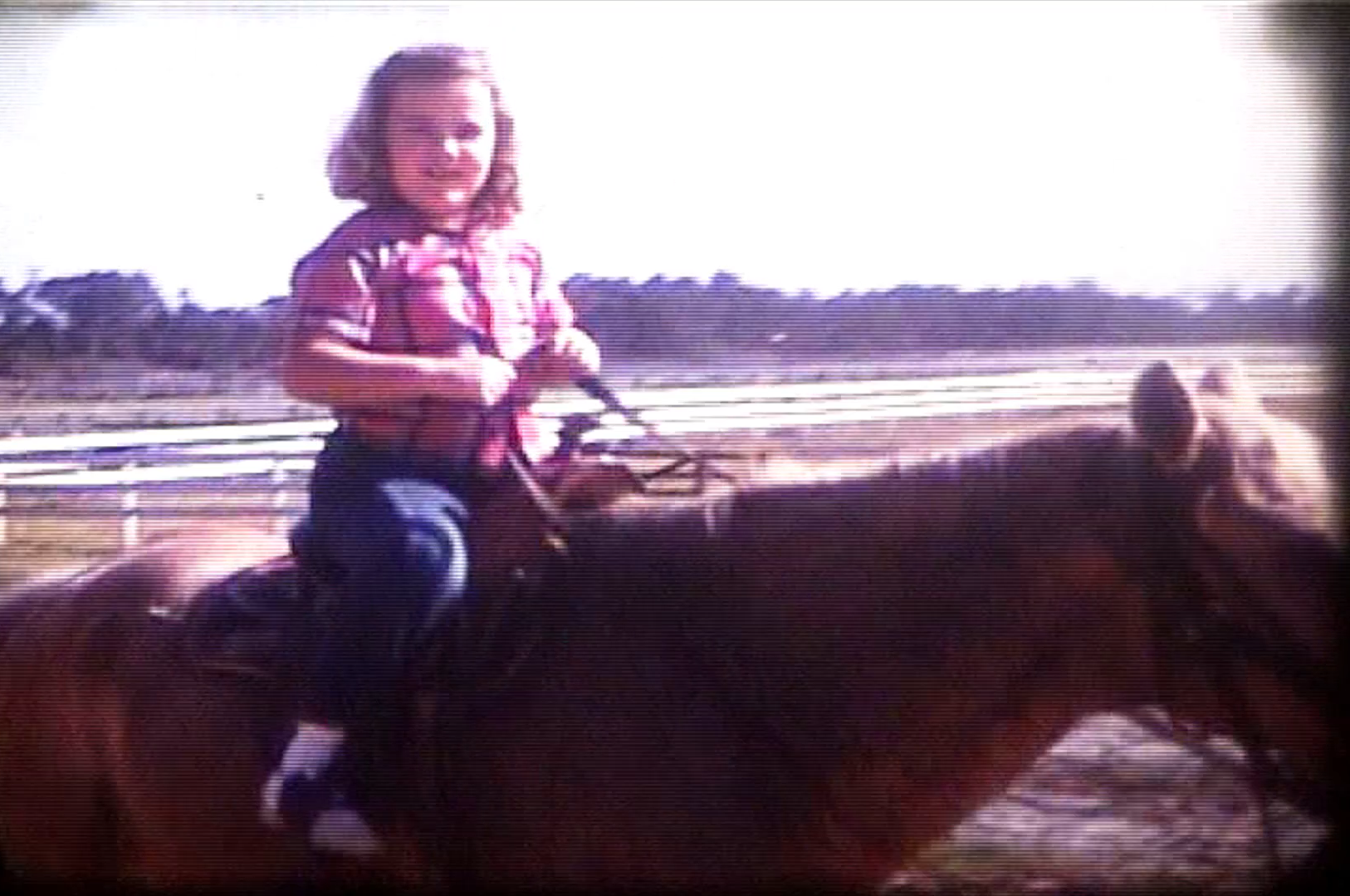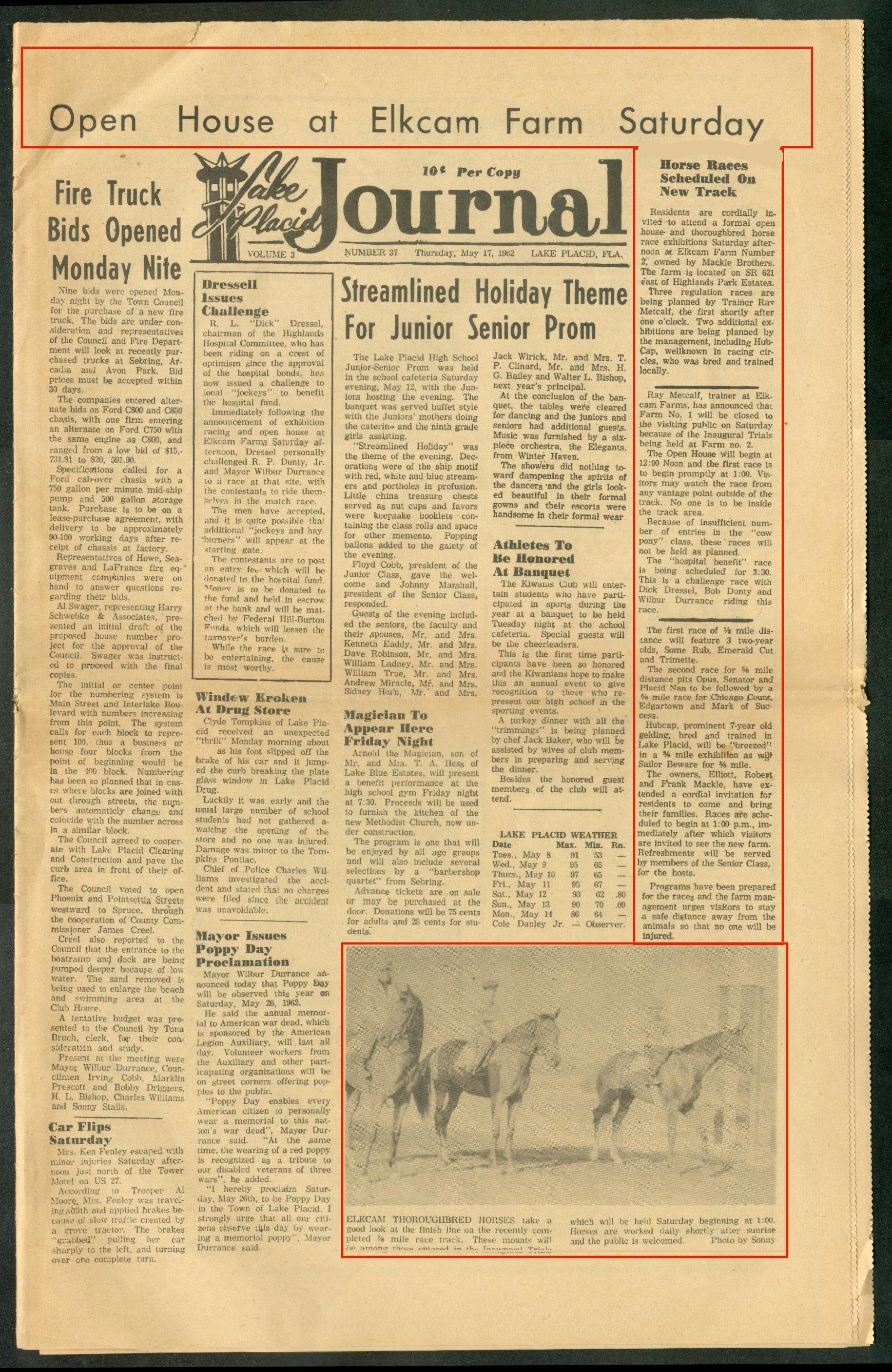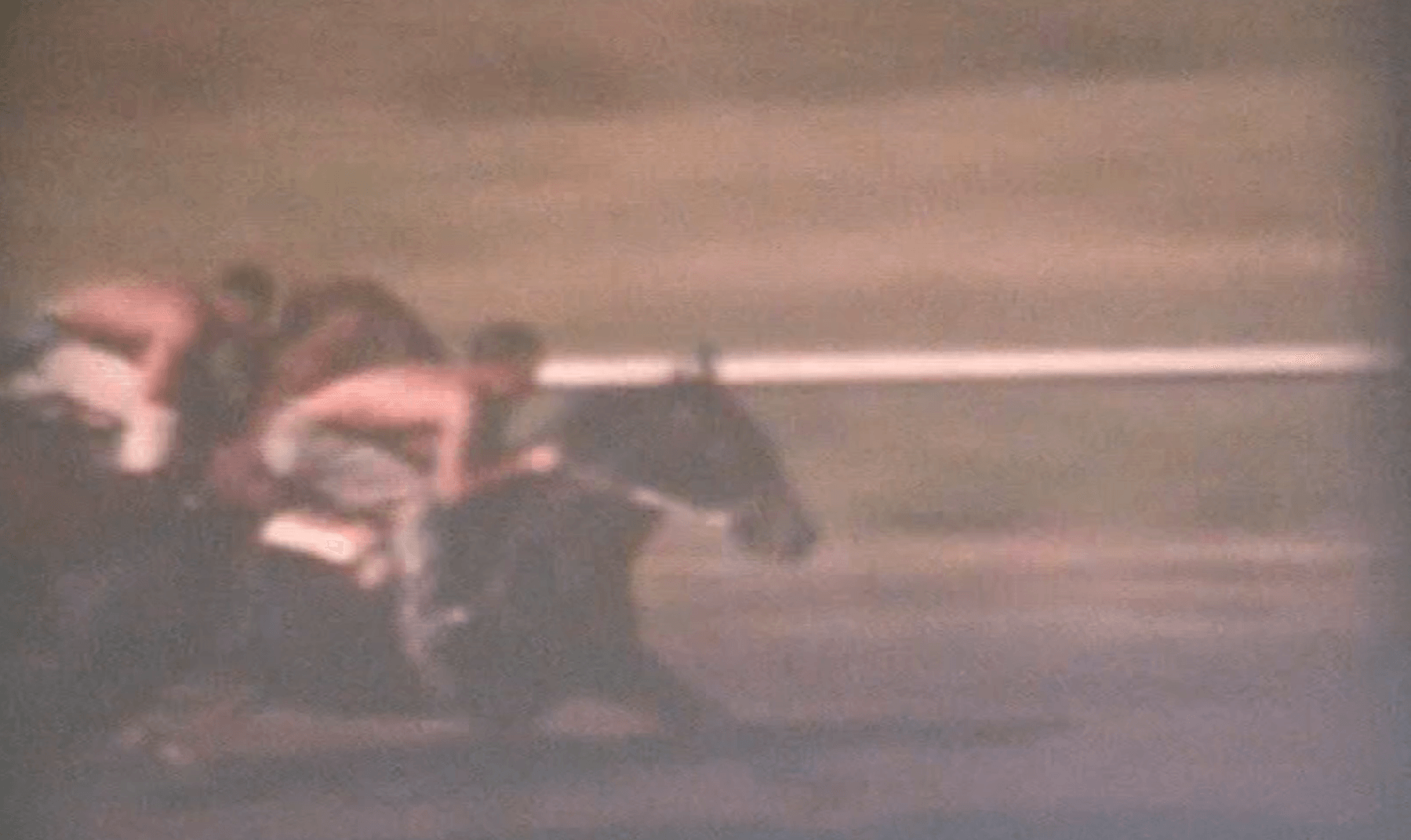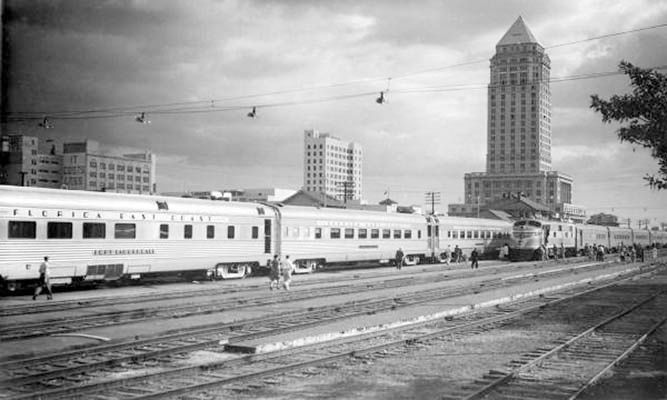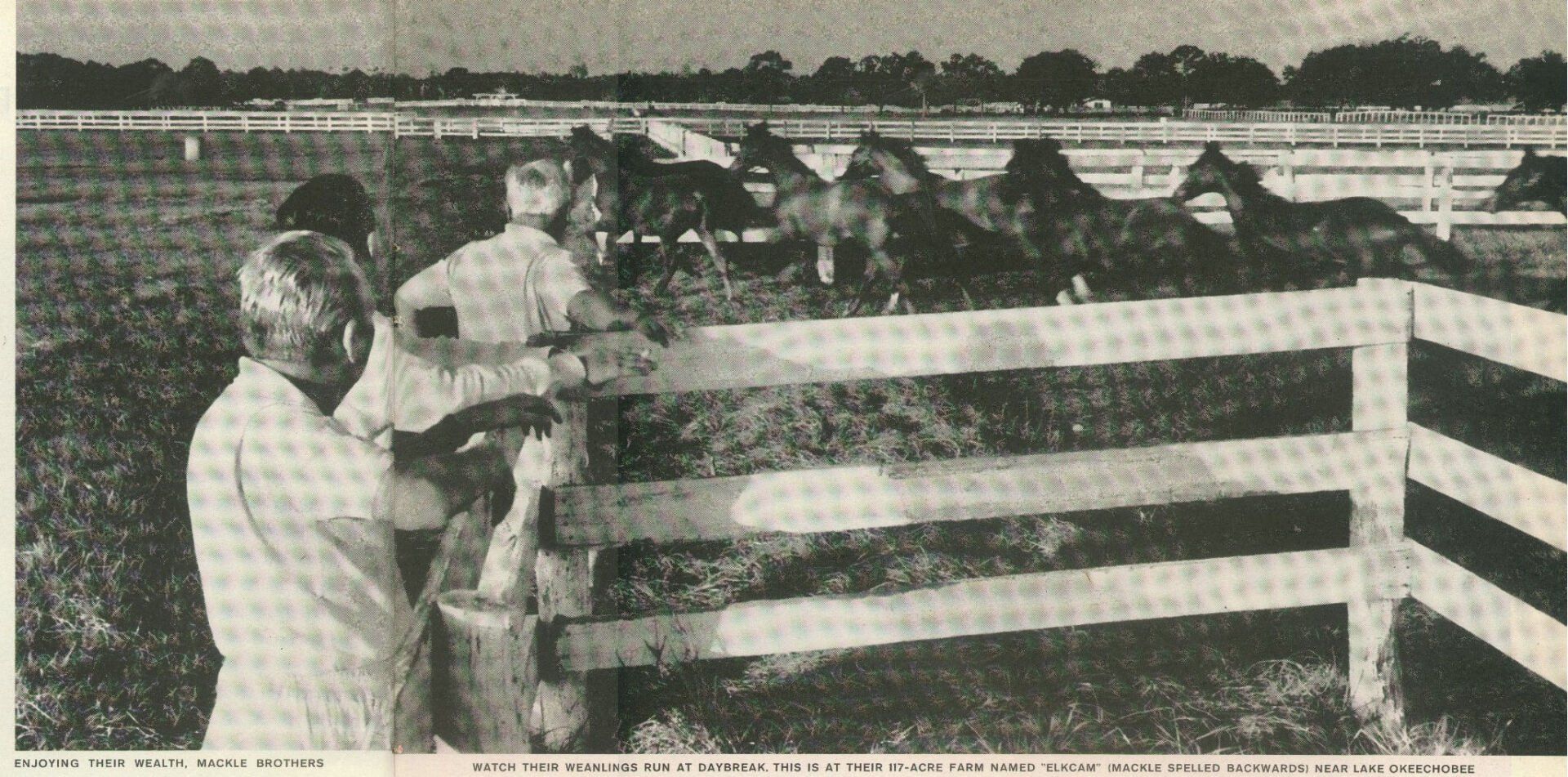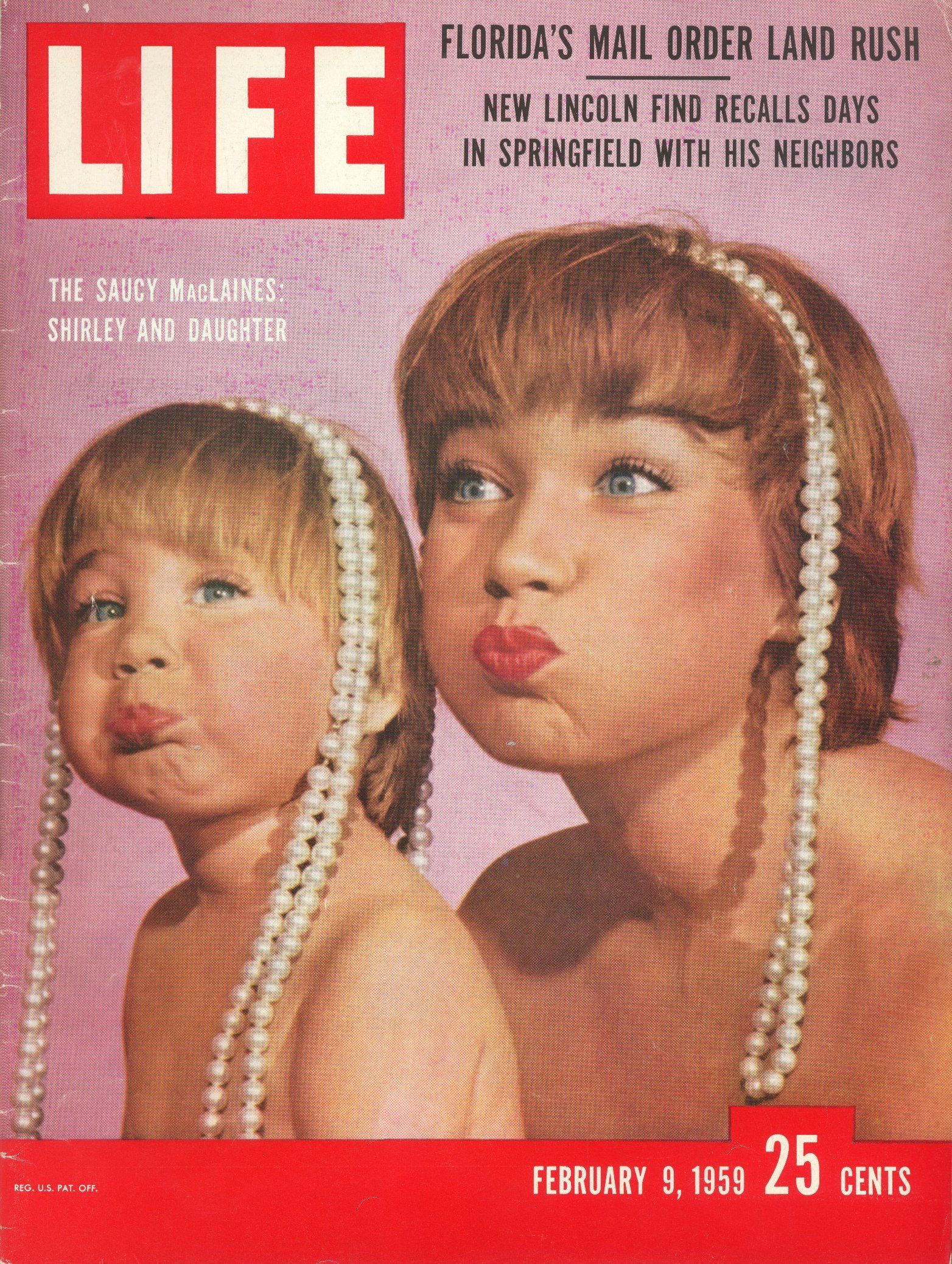ELKCAM FARM – THE FIRST TWELVE YEARS
November 2021
Frank E. Mackle III

Twenty years ago, or more I wrote The Frank E. Mackle Jr. Story.
It can be viewed at the home page by clicking on the icon.
In it there is a section titled: The Horses and the Farm.
It is mostly an account of the Mackle Brother’s forty plus year thoroughbred racing record.
But I want to elaborate on the Farm – sometimes referred to as “The Lake” - as I remember it in the 1950s and early sixties.
We have recently re-acquired an original part of the farm and we are now beginning construction on a new house there. It got me to reminiscing … at the age of 77… about my early days at the Farm when I was a child growing into a young man.
As one of the last of the generation to remember the early days, I will focus on the first ten to twelve years, starting when I was about seven until about nineteen years of age. Later generations can take it from there.
The Farm
By “The Farm”, of course, I am referring to the property in Highlands County, Florida which has been a God-given retreat for our family for seventy years this year and – now – five generations of Mackles.
As told in the larger story, The Mackle Brothers love of thoroughbred racing, resulted in them getting into the breeding business as well.
Their first move into the business was to buy a property in Lexington, Kentucky, the center for Thoroughbred horse breeding industry.
I was only a child and have no memory of that property. A few scrapbook items still exist, however.

But they wanted something closer to home.
In the 1960s Ocala, Florida emerged as another center for the Thoroughbred breeding industry. But the Mackles were ahead of their time. The home for their thoroughbred horse breeding business – and a place that the Mackle family could enjoy – would be in in south-central Florida, in Highlands County near the town of Lake Placid.
It is interesting to note that this pre-dated, by four or five years, their moving their business out of Dade (now Miami-Dade) County to Broward County, Charlotte County and beyond. Apparently, they were already looking around Florida. Of course, they had first come to Florida only thirteen years earlier to Delray Beach and built and sold homes in Palm Beach County and – briefly – Manatee County before the war. The war had taken them to Key West and to the west coast of Florida, at Placida, as well. So, I guess, it is not surprising – since travel was strictly by car over narrow two-lane roads which crossed Florida – that they had discovered the Lake Placid area.
Driving from South Florida or from the east or west coast of the state one travels over many miles of flat land. Those roads pass through the everglades from the south and the low-lands and flat pine lands from the east and west. Then - to one’s surprise - the land rises into the rolling, lake dotted ridge that extends from (and characterizes) the Orlando – Lakeland areas to the north. As can be seen on the following topo map, lands range from five to ten feet surrounding the ridge to over 100 feet in elevation on the ridge. With that rise in elevation comes a change from lowland muck to rolling hills, sandy soil – perfect for raising citrus trees – and beautiful freshwater lakes.
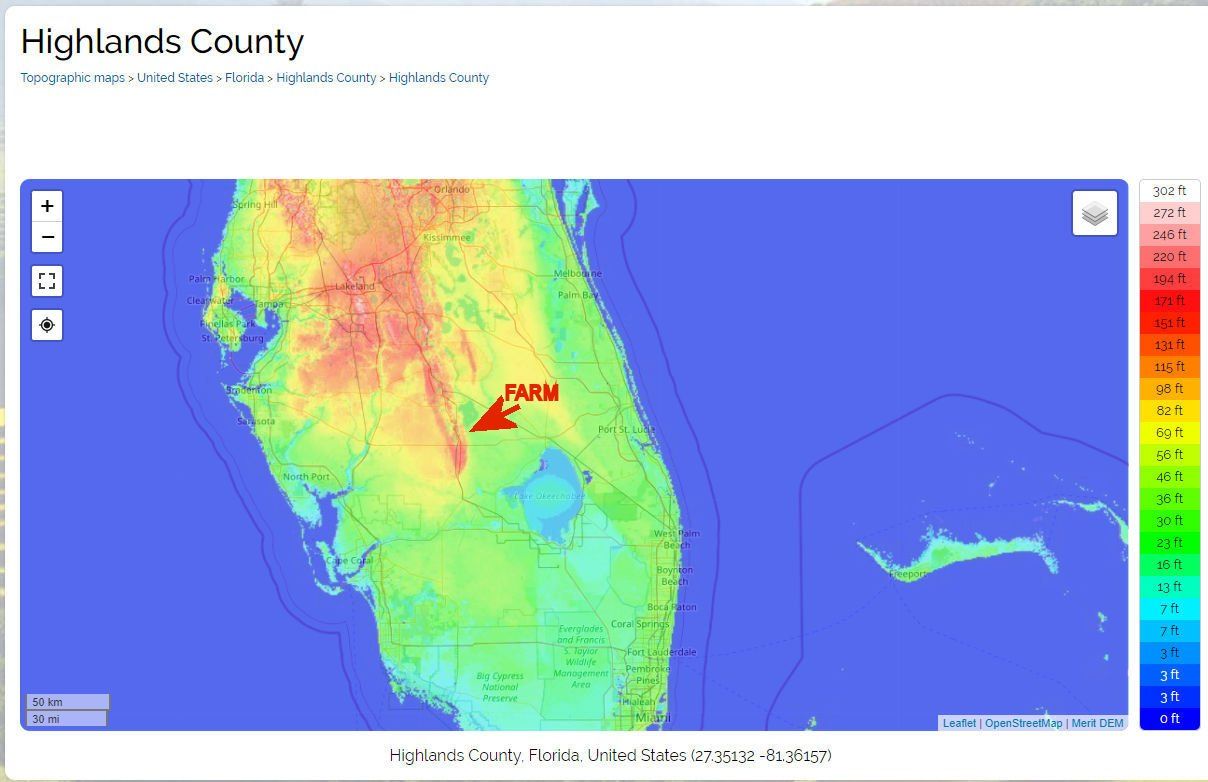
On January, 15 1951 The Mackle Brothers purchased (what the paper said was) 120 acres of land on Highway 621 in Highlands County Florida, near the town of Lake Placid.
They paid $27,500 for it.
The story was told for years how the Mitchells had bragged about “taking” those Miami-uns”.
It was headlines in the local paper!
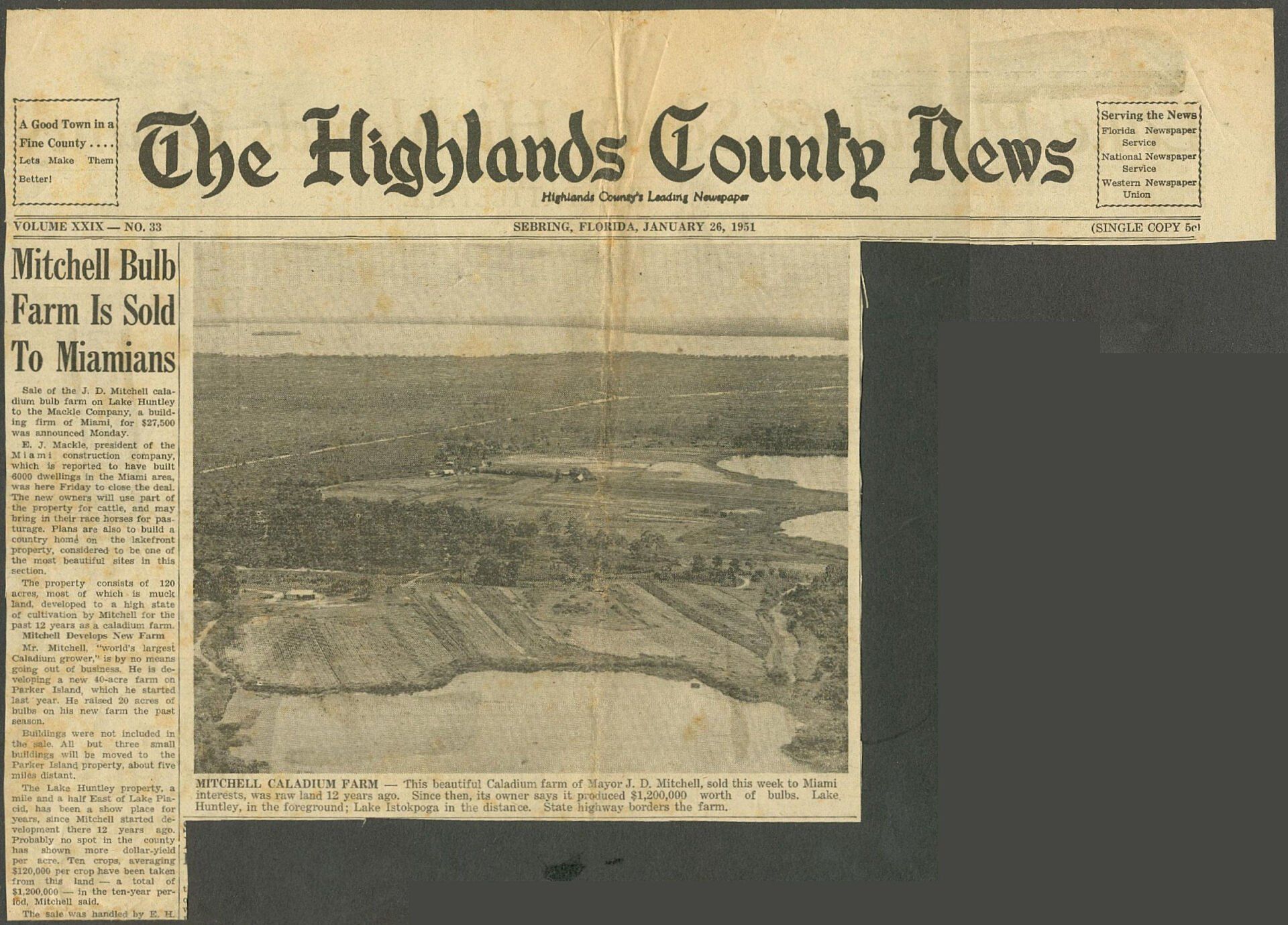
The picture is from the west with a portion of the island showing on the right. Also, on the right can be seen the canal which was dug prior to the Mackle’s purchase to fill the “island” (as I understand it). The areas west and east of the main road into the property was being used to grow caladiums – a significant industry in Highlands County for years. The low muckland was perfect for that purpose.
Below is a copy of – what must have been – plot plan that was part of the offering. Unfortunately, someone (me?) has written over it. But you can still detect the land uses (i.e. caladium fields) described in the offering. To the right is the 1951 Deed to the Farm.
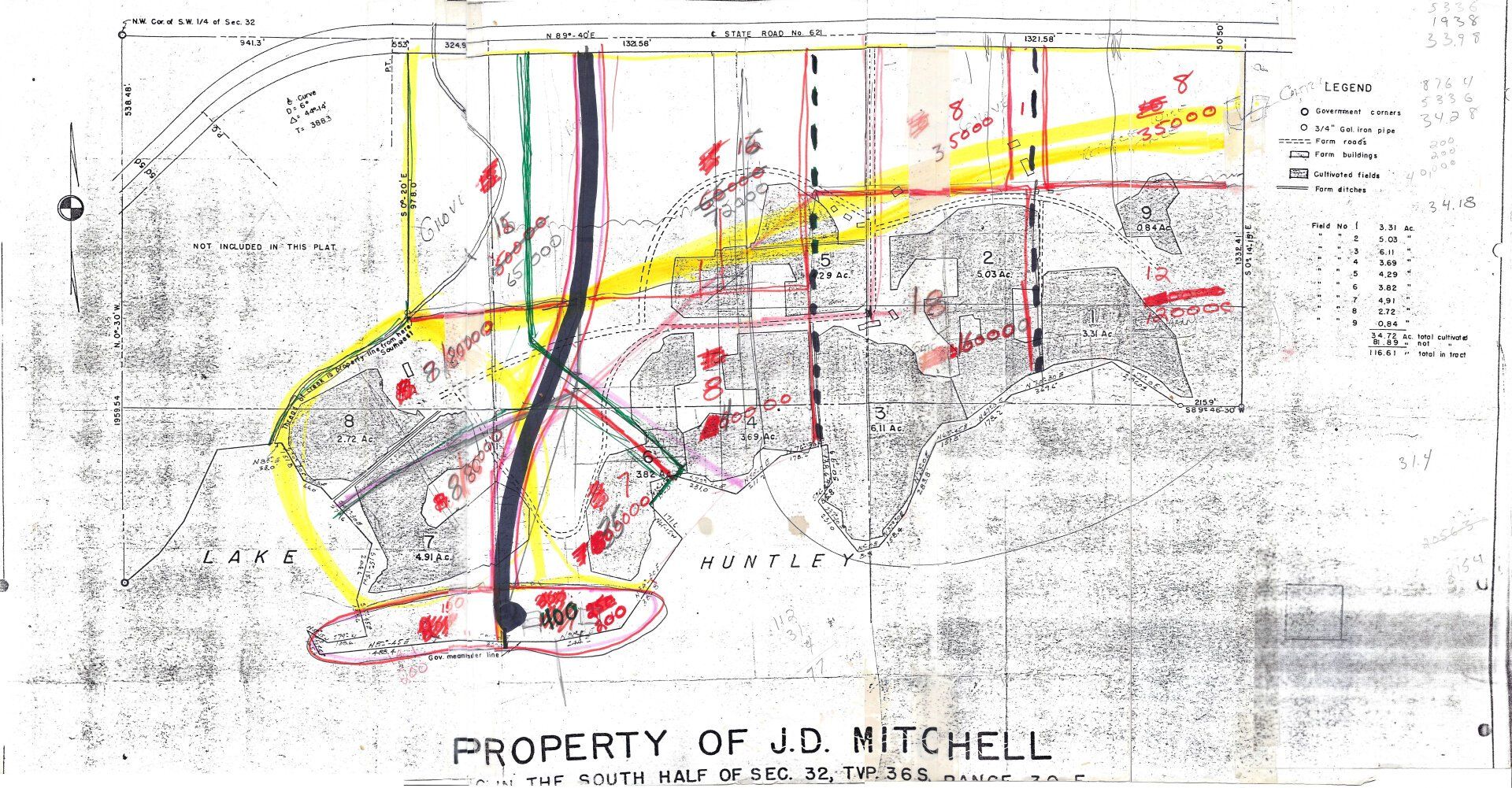
I’ve always thought that the Mackle Brothers then built the two houses that we were to enjoy for the next ten years or more. They were simple frame cabins built on concrete piers. But the fact that they were so unlike the homes they were building in Miami and their minimal design makes me wonder if they were not already there when they bought the property. An unsolved mystery!
In any event the “main cabin” was a 1,000 +/- foot one bedroom, one bath structure with fully paneled walls and a high paneled ceiling. There was one small – maybe 12 x 12 – bedroom that Nancy and I used. My memory is of twin bunk beds in our room. We often had childhood friends with us.
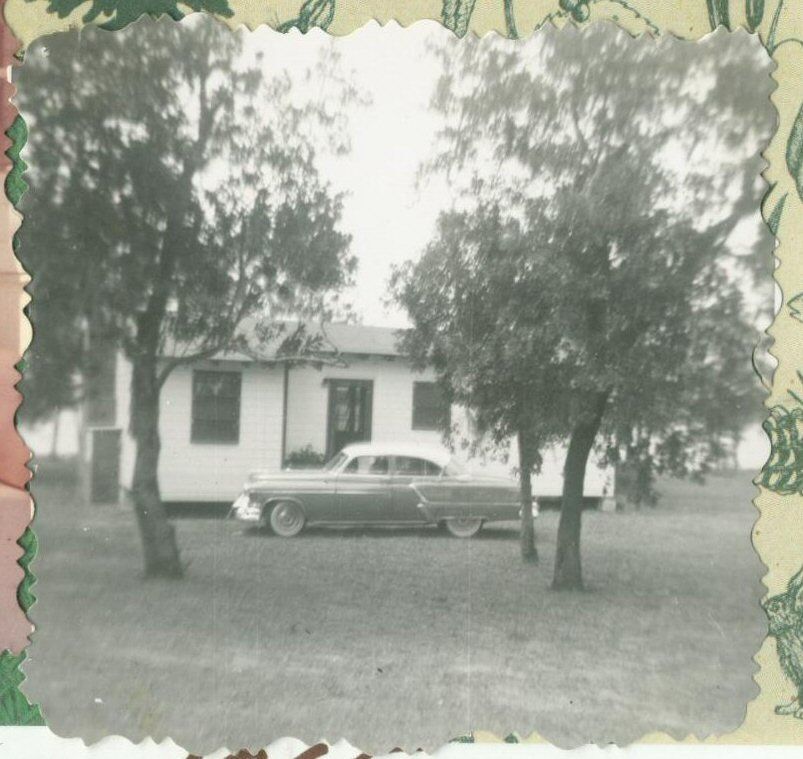
The sleeping accommodation for our parents was a pull-out couch in the living room – hard to believe knowing the comfortable homes they were used to in Miami! As can be seen in the picture to the right, there was a single wall air condition unit in the living area. Remember, air condition was a very new amenity in homes – even in Florida.
The living area included a bar off the kitchen, a dining area, the pull-out couch and some easy chairs. I don’t believe there was even a TV in those early days. Now that I think of it, it was years before there was any regular TV broadcast available in the Lake Placid area. However, in researching this, I found pictures of a tall antenna outside the Main Cabin in the mid or late fifties. A vague memory came to me of very fuzzy and intermittent tv out of Fort Myers. I don’t think that TV was a very big part of the farm weekend.
The rear of the house – fronting on the lake – was a long screened in porch with a ping pong table. It is where I crafted my incredible ping-pong skills J.
The children were put to bed early. The adults were known to party well into the night, often playing poker on the dining room table.

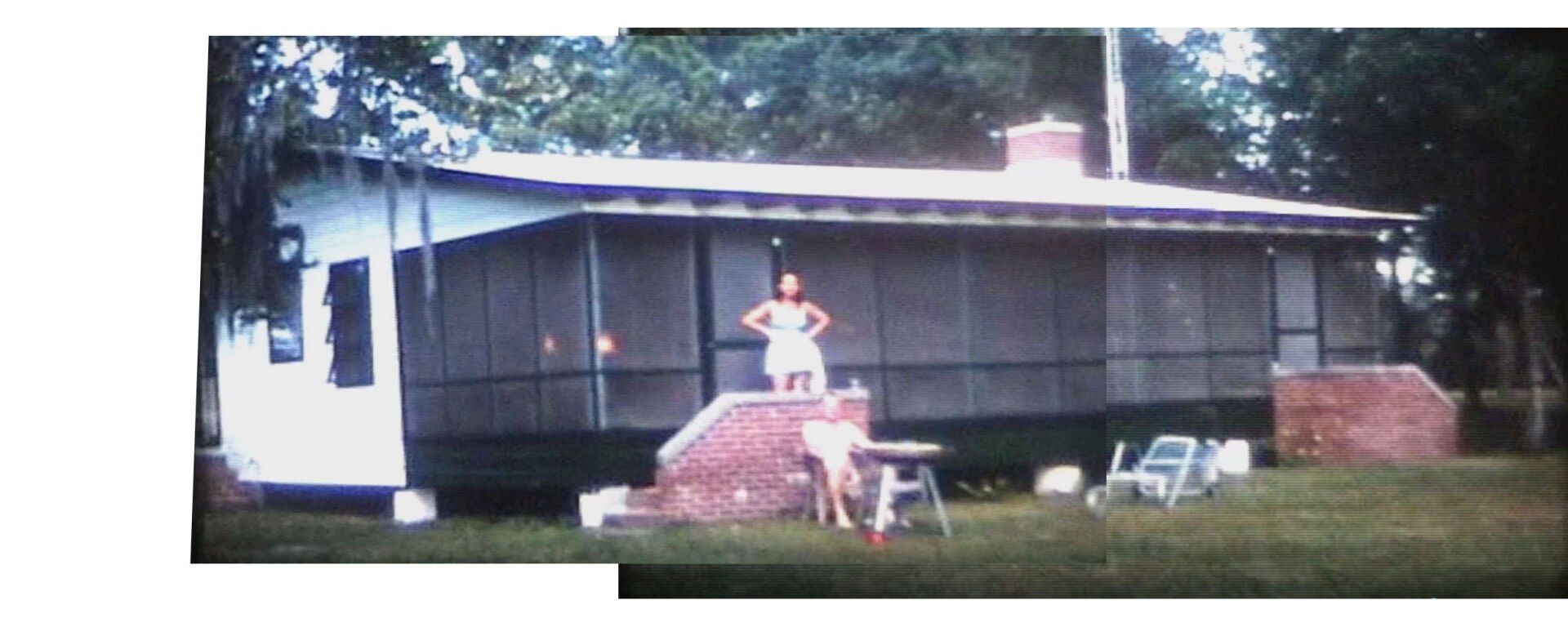
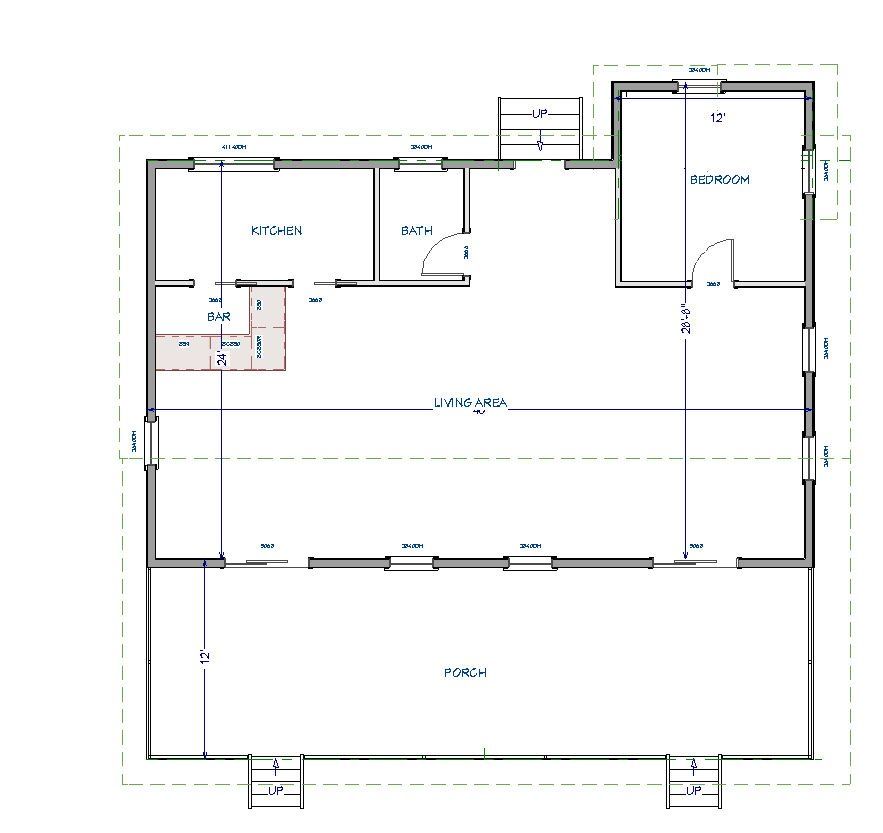
Main Cabin Floor Plan - 1950s
The “Guest Cabin “ was even smaller – less than 500 square feet of living area with two bedrooms and bath between and with a porch in front. When it was added on to – sometime in the mid 1960s – it became a complete cabin with a large living room, a second bath, a kitchen and a carport. But for the first fifteen years or so was a primarily used an extra two bedrooms.
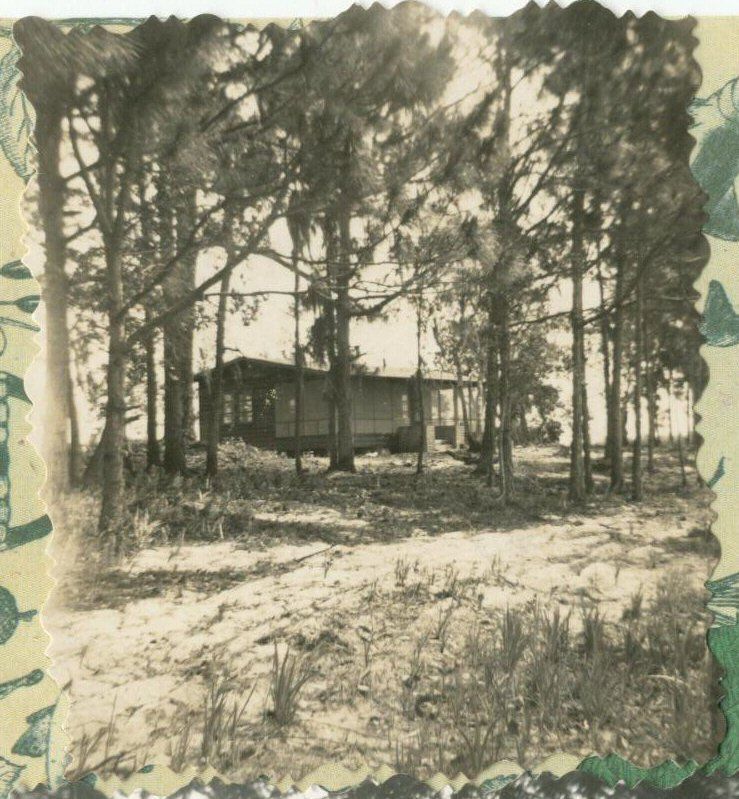
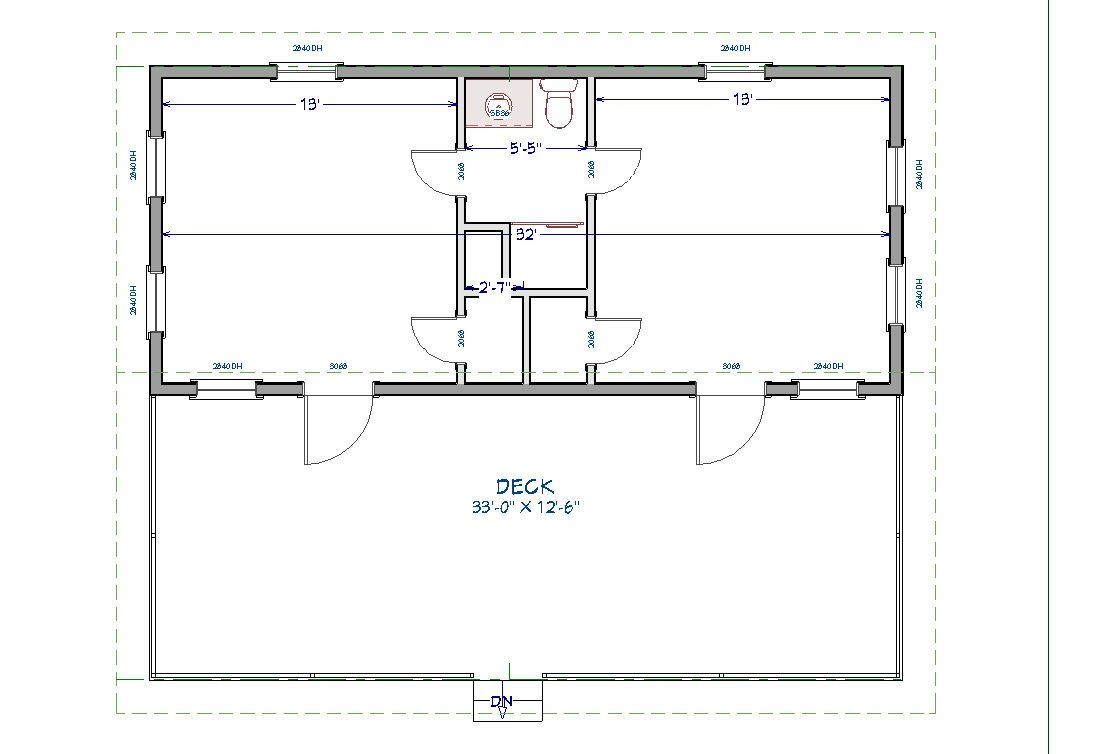
Guest Cabin - 1950s
In the early days – and for most of the fifties – the farm was in great demand. The three Mackle families – all with young children – reserved the farm frequently. Often two families would spend the weekend together (there wasn’t room for all three families). On other occasions other relatives and friends were invited.
My Mom and Dad’s announcement that “we’re going to the farm this weekend” brought excitement and anticipation to my sister and myself. “Can we bring friends?” was usually the first question.
We came home from school on Friday and jumped in the car for the long ride to the farm.
For my Dad, the trip in the 1950s was a bit different from today. I believe Dad’s first air-conditioned car did not come until the early 1950s. There were no expressways – even in the city. Travel from our house on Sunset Island to the farm started west across the Venetian causeway, then north on Biscayne Boulevard and then west on NW 36th street where, at 42nd Avenue, it connected with Okeechobee Road (U.S. 27) just north of the airport.
Soon the city was left behind. The two-lane U.S. 27 would take us all the way to Lake Placid. The next milepost was Andytown, at the junction of SR 84 coming out of Broward County and U.S. 27. Andytown no longer exists and even then – in my memory – was only a country store with a gas pump. But it was a break for us children.
For the next forty miles out of Andytown the scenery was everglades and then sugar cane fields. In certain times of the year black clouds of smoke were prevalent as the burning of the fields was part of the harvesting process for sugar cane, a sight that continues to this day.
The journey continued north. I’m sure we went through South Bay but the next town we looked forward to was Clewiston
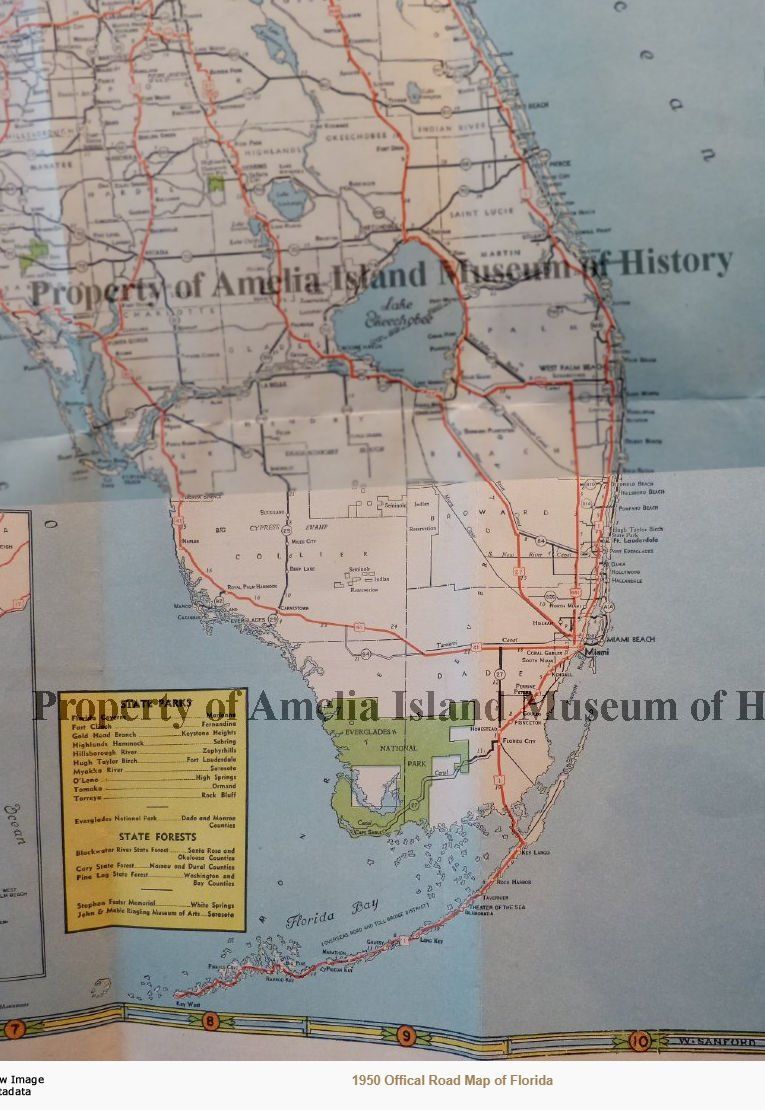
1950s Map of South Florida
Highway 27 provided a few other diversions for us. I remember “Burma Shave” type signs (some on cypress tree posts) in and out of Clewiston. They promoted information for the attractions along the side of the road. The Cypress Knee Museum and Gatorland near Palmdale were places of curiosity that breezed by, but were never visited, on the way north.
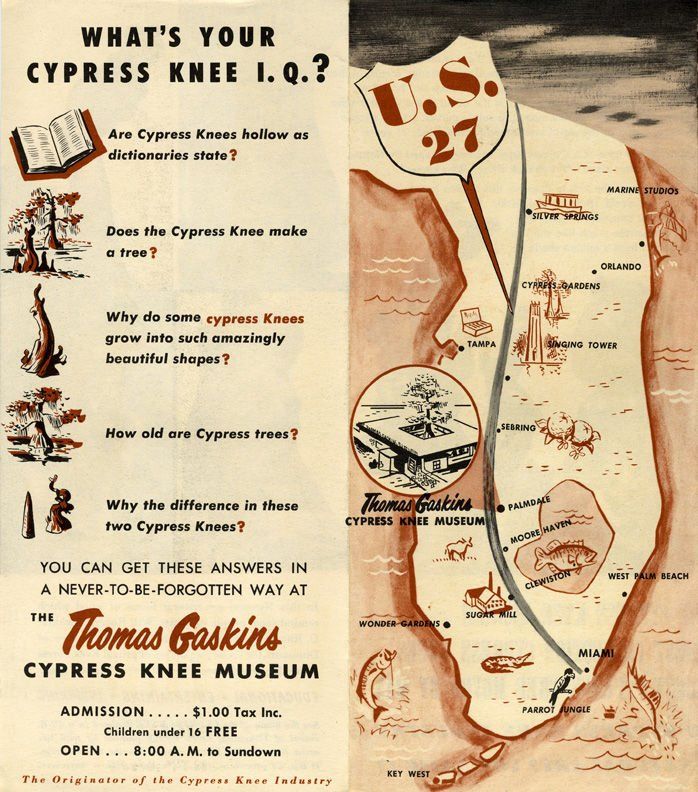
In Clewiston we would often stop for dinner. Later there was the Bar-b-que place but in the early days we stopped at the Clewiston Inn. The Clewiston Inn was an ancient hotel operated and kept alive by the sugar interests in the town. Sugar was, and is, the major industry in that area. For us children it was a bit of a drag! It delayed our getting to the farm and was an incongruous, rather snooty, hotel with tablecloths and silverware and black waiters in uniforms. Anyway, we were soon on our way for the last leg of the trip!
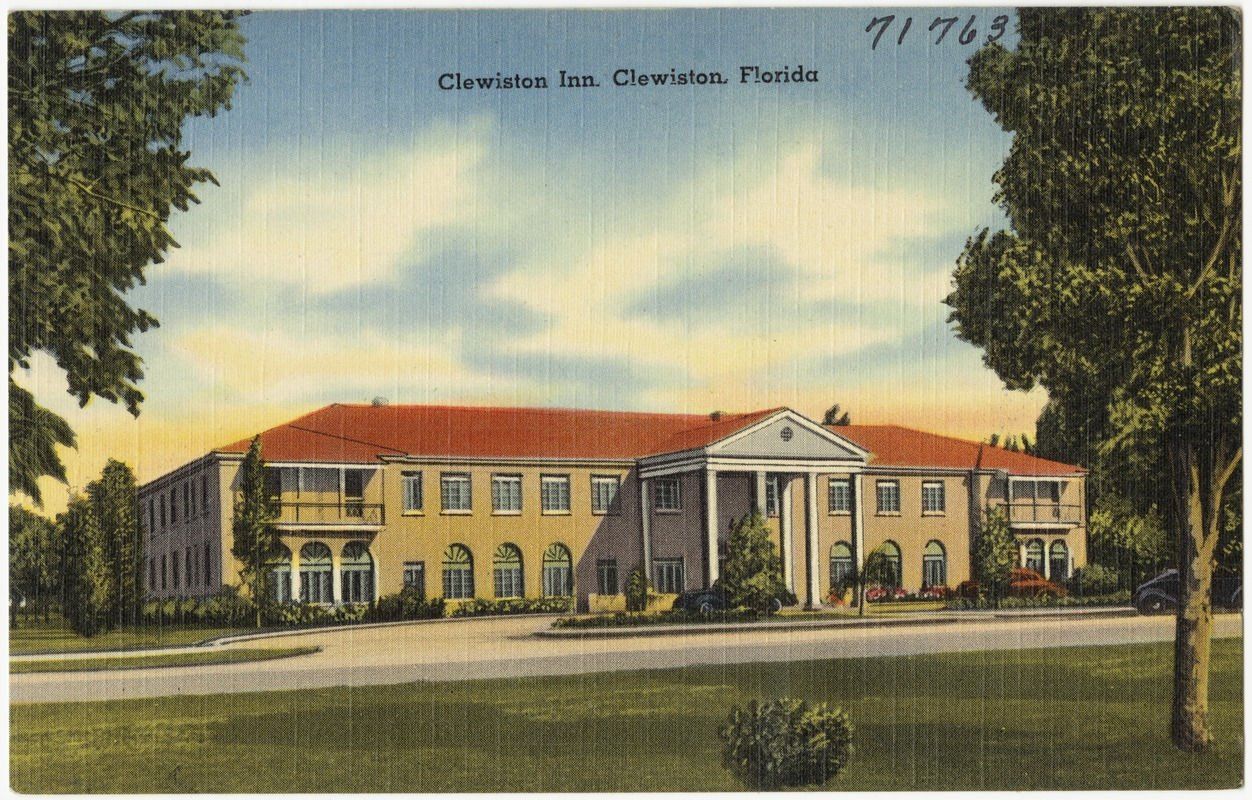
The Clewiston Inn
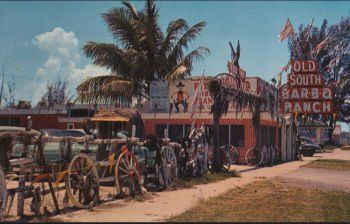
Old South Bar-B-Q Ranch
Now the scenery changed a bit. Swampland turned to flat cattle land. Pine trees were dominant out of the car window.
(as I am writing this I am realizing that – other than the change from two lanes to four lanes, the scenery hasn’t changed much! J)
Another half hour to forty-five minutes passed. Moore Haven went by in a flash. Fifteen minutes later we crossed the bridge at Fish-eating creek. Palmdale a town of three or four structures passed by.
Now the scenery changed again. Miles and miles of orange groves appeared, and the road began to go uphill! (Slightly!)
While this journey is now well etched in my mind, I’m sure – as children – we were barely aware of what was outside the window.
My mother had packed comic books and other diversions for us. What I remember the most was Dad singing songs for much of the trip. He had been in the Glee Club in college and, in my memory, had a pretty good voice.
And, yes, my Dad had a great sense of humor as well!
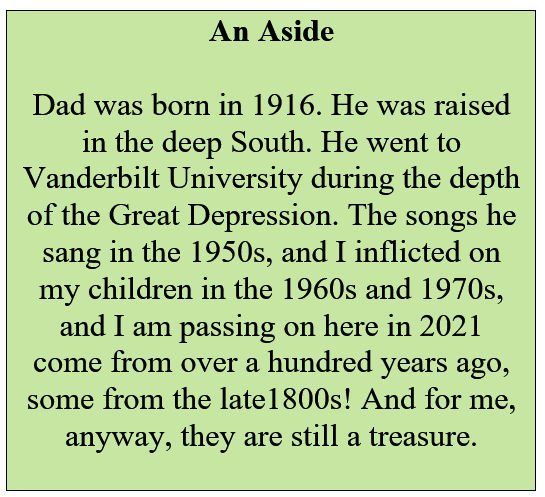
Casey Would Dance (Dad’s version) With the Strawberry Blonde and the Band Played On was one of his favorites. (to the right are links to the closest and oldest examples I could find on YouTube and the internet. Wish I could hear Dad singing them again.)
Casey Jones was another
Then there was Throw in a Hunk of Bacon. (Couldn’t find the song but here is the apparent source of his lyrics.)
Then on special occasions... Passengers Will Please Refrain
And the unforgettable Alice Where Art Thou Going
I’m sure my children remember them – and many more, as I continued the tradition and added a few of my own years later!
Now we pass Bears Den (another name lost to the ages) at the intersection of U.S. 27 and S.R 70 crossing the state from West Palm to Arcadia and the west coast of the State. I don’t remember the gas stations that are there now but there was always an Orange Grove Stand.
But we were getting close!
Nancy any I were getting anxious (annoying?) by then.
But, on every trip, there was this game. Who could see the Tower first???
The Tower was the end of the long trip!
Nancy and I scanned the front window of my Dad’s ’54 (or whatever) Buick searching the horizon!
I must admit, Nancy usually saw it first.
Finally, the turn on to Highway 621 and the white fences of…
THE FARM!
We were in heaven!
The Farm in the Fifties
From the white fences an entrance appeared, and one turned right onto a red clay (redder then than now, in my memory) road that led to the cabins. On the right was a small storage building To the left another red clay road and white fences to the mare barn and the yearling barn and further down on the right was the managers house. More white fences and then the sight of the lake and the Main Cabin!

In those days trips to the farm were strictly weekend affairs. I don’t ever remember a week-long trip as child.
We would arrive around sundown on Friday.
There was usually another family or friends with us. Often either Robert Mackles or the Elliott Mackle would join us. Just as often my mother’s siblings (Jerry or Janet or Jack) and their families would join us. I remember the Jim McCaughan family and their children joining us on occasion as well. Often Nancy and I brought friends, Jim Worden, Marilyn Farrey, Ellen Codomo, Kathy Cahill and others.
If early enough Mom might have gone into town to “Bubba’s” IGA – or was it Hartzells? In any event it was long before Winn Dixie and Publix. If not, that would be an early Saturday morning chore. She may have brought food with her as well.
We children were put to bed early … and woke up early.
Saturday was the big day. The weekend would never end as far as Nancy, and I were concerned.
Seems rather tame by todays activities but …
New Paragraph
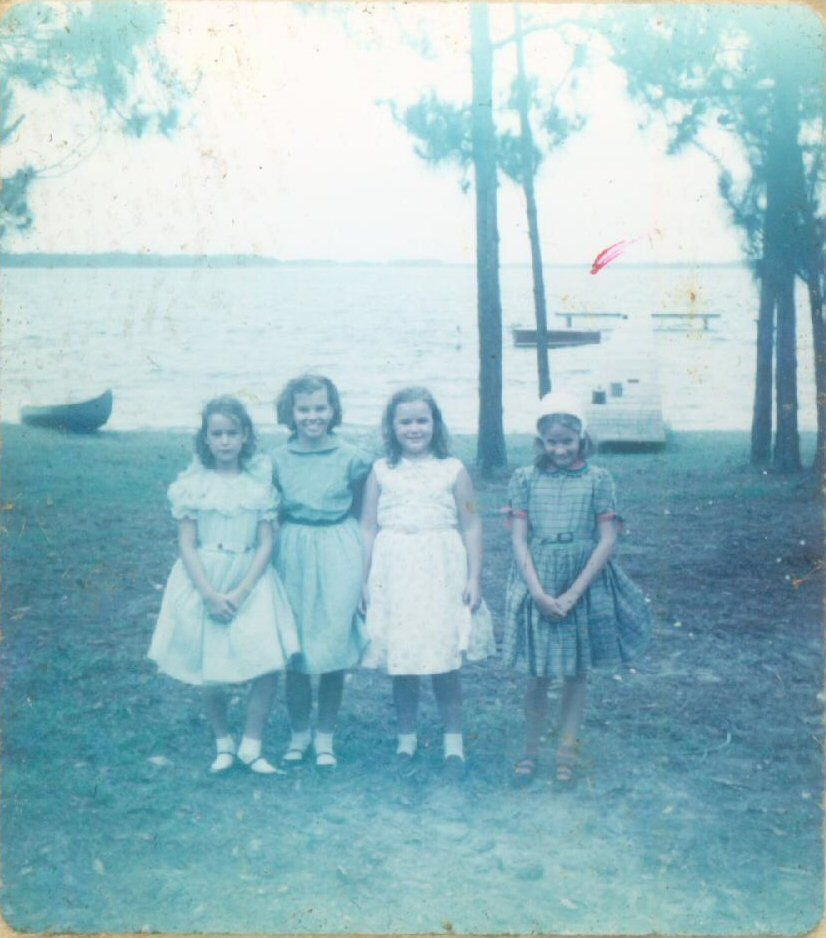
Nancy and Friends
Early morning bass fishing with Dad as the sun came up. Fill the bait bucket with minnows. We had either gone down to the bait store the night before or the farm manager had taken care of that chore.
A trip to the bait store was always a hoot. On a back road, south of town, in an old frame house, dogs and cats and spiders everywhere; an open garage set up as a store, a few lures and bobbers available, tanks of various live baits, minnows (shiners they were called), crawdads, a “worm farm”, a fat old man or woman happy to help, the smell of chlorine from the tanks and plans of catching “the big one”!
In those early days, the boat, a 16 foot +/- bass boat with a ten-horsepower outboard, was kept on a trailer and the manager would have it in the water for us, usually pulled up on the beach. The ramp was at the west end of the island on the cove.
Early, in the 1950s, Dad and his brother Elliott, who lived a few blocks away from us on Sunset Island in Miami, worked for months in Elliott’s garage building a wooden bass boat for the farm.
There was always a wooden, screened, live bait box near the dock or the edge of the lake. I was assigned a small net with a two-foot handle in hand to fill up the metal can with shiners and put them in the boat.
Dad would crank up the Johnson and - in the still dark morning with the rays of the sun shining through the trees on the east side of the lake - we would head to the first of several favorite fishing spots. They were mostly on the north end of Lake Huntley along cattail or lily pad areas. With only a ten horsepower outboard I didn’t see the south end of the lake for many years
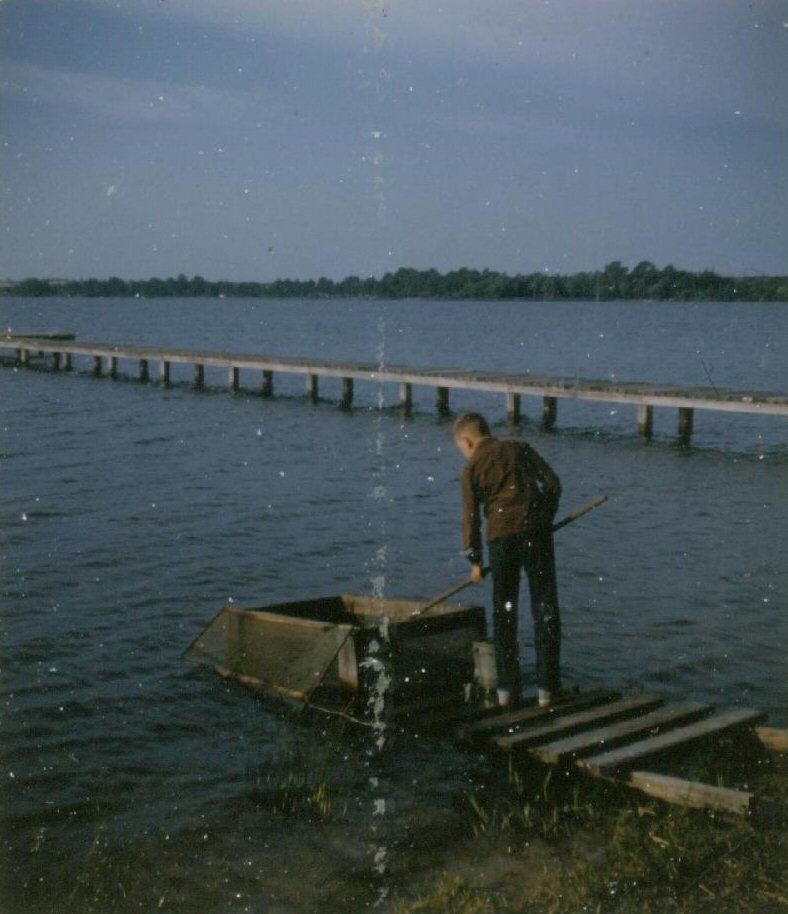
Bait Box
Jim Worden taking the honor
Dad’s usual way of fishing was with a bobber and a shiner… “lazy man’s fishing” he called it. The bait bucket would be lowered over the side so the shiners would get fresh water. Reaching into the bucket a minnow was grabbed and hooked through its lips. A bobber was attached about two feet above the hook. We would cast our lines out as near to the weeds as possible. Ten-year-old Frank would often get his hook tied up in the weeds. Dad was patient. We would stare at that red and white bobber floating on the black water for many minutes hoping to see it bob under. Then a slight bob… something was chasing the minnow! Hopes arose! Then, sometimes, the bobber would disappear! A fish was on. If you timed it right – give the fish a second or two to run and swallow the minnow – heave back on the rod and the fight was on!
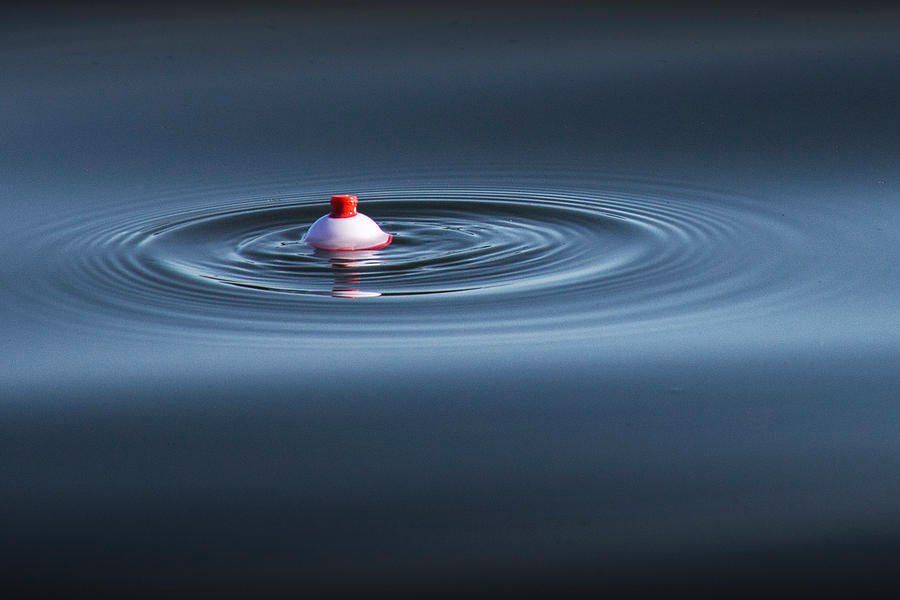
One or two hours of fishing was enough. The sun was getting hot. And we hadn’t had breakfast yet. If I was lucky, Dad might let me steer the boat home. Sometimes we came back “skunked”. As Dad would say, “the fishing was great, the catching not so good”. But most of the time there were trophies to show off. It was there I learned to clean fish!
I do remember often going to bed, closing my eyes, and seeing a red and white bobber in the blackness!J
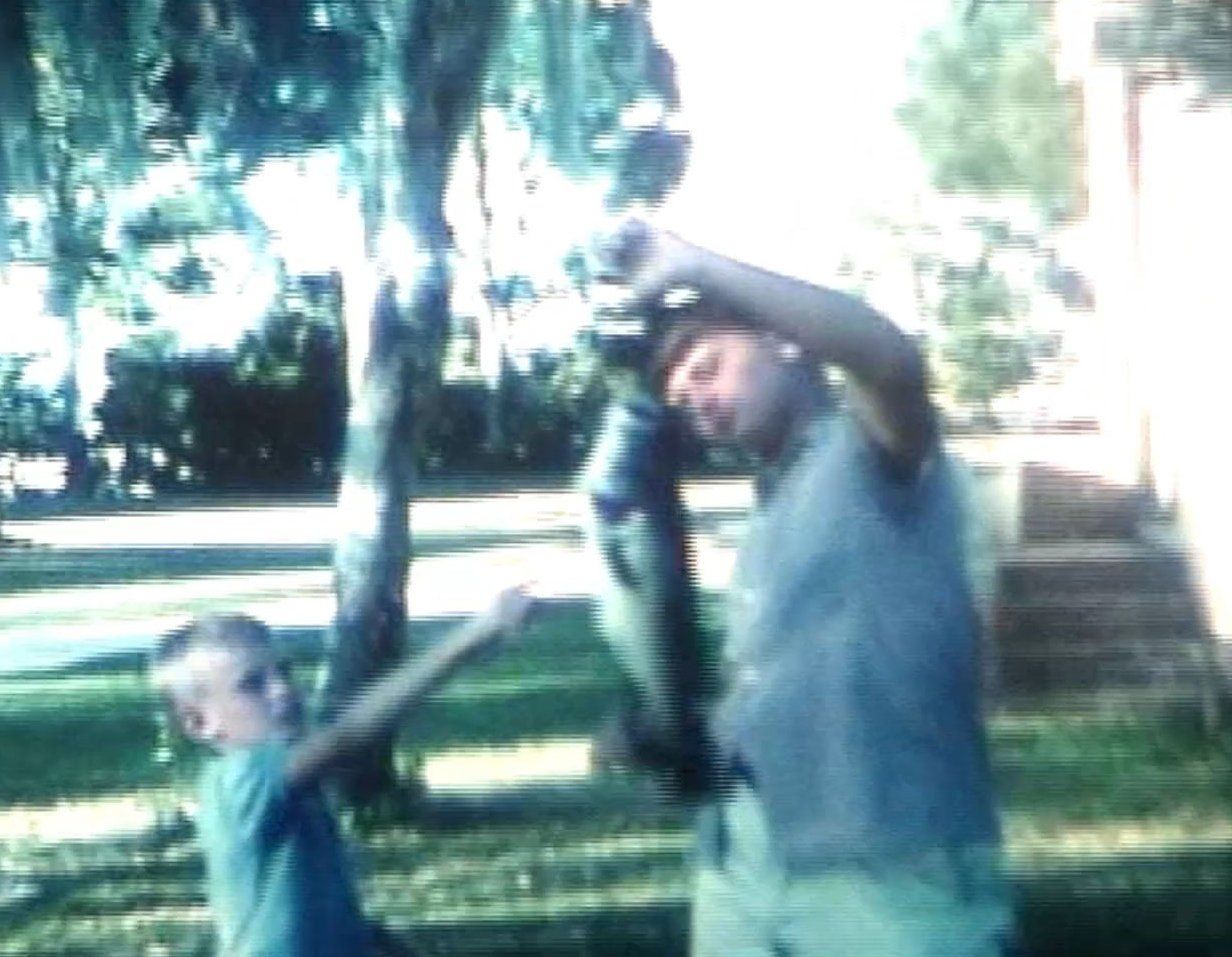
Jimmy McCaughan and I
Meals at the Farm were huge! Pancakes and bacon for breakfast was my favorite. A quick sandwich for lunch… then back to the water. Maybe Bar-B-Q for dinner. Sometimes Dad would cook hamburgers on a small grille on the lawn.
Later in the evening, in the cooler months, we might have bonfire near the lake….toasted marshmallows! Yummm!
If my uncle Jerry was with us the weekend had a little different flavor.
Jerry was a great guy… an outdoorsman… an avid hunter … practical joker … a very good golfer… and more. Jerry was nine years younger than his sister (my mother) Virginia and fifteen years older than myself. So, he was sort of the “older brother” I looked up to.
But, as I inferred, he marched to a different drummer.
He was always in on the fishing but was more into casting lures than watching a bobber.
I remember to this day the night – it may have been around Halloween - he went outside in the pitch dark and peered into the window of our small room and scared the bejeezus out of Nancy and I.
He took me late-night frog gigging one or two times.
And then there were his ghost stories around the bonfire!
Not the usual weekend … but very fun!
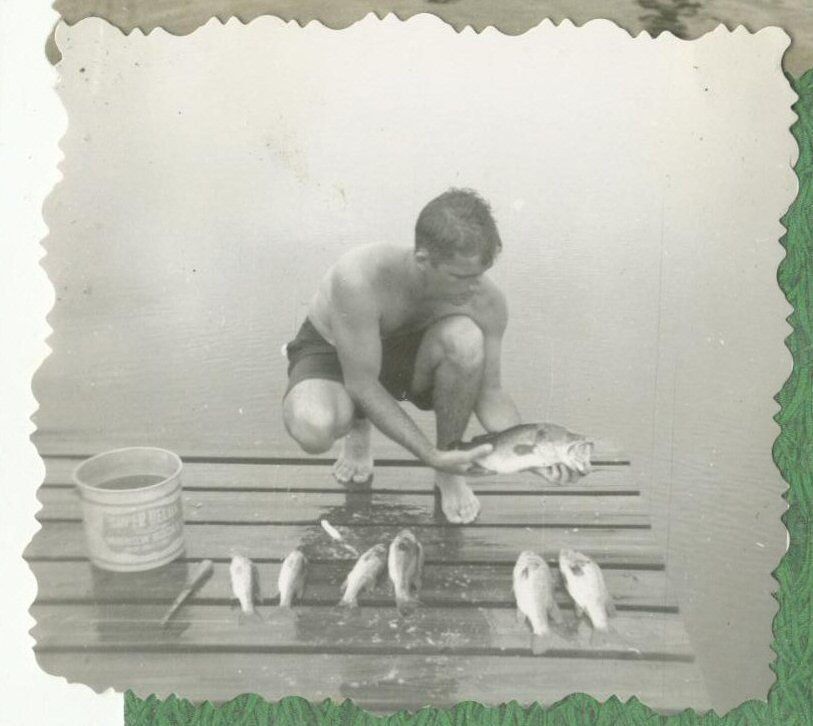
It seems, looking back, that ping pong was going on all day. Dad played with me often and taught me the game. Singles or doubles, it was a constant fill-in between other events. I got pretty good and played often … until my own sons started beating me thirty years later!
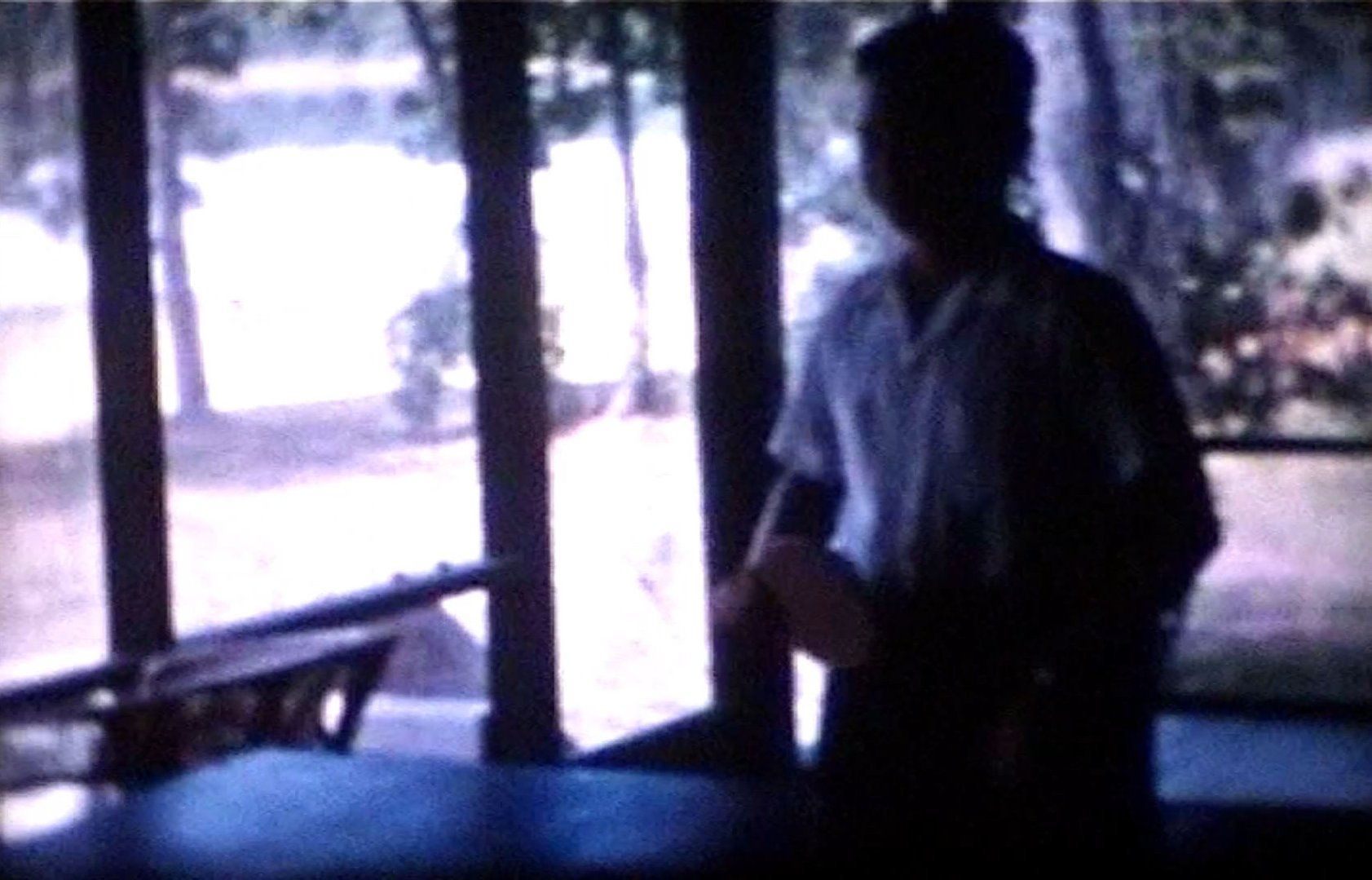
In the evening, after dinner when things settled down, there were board games, Monopoly was a favorite, and card games. I’m sure that’s when I was introduced to Slapjack.
Water activities were very different in those days. There was no high-speed boat, no sailboats, no water skiing, or wakeboarding. Even the water slide did not come until fifteen or twenty years later.
For many years the dock was just a long pier into the lake with a wider deck at the end. There was no cover unless someone took an umbrella out.
But we were still in the water all day!
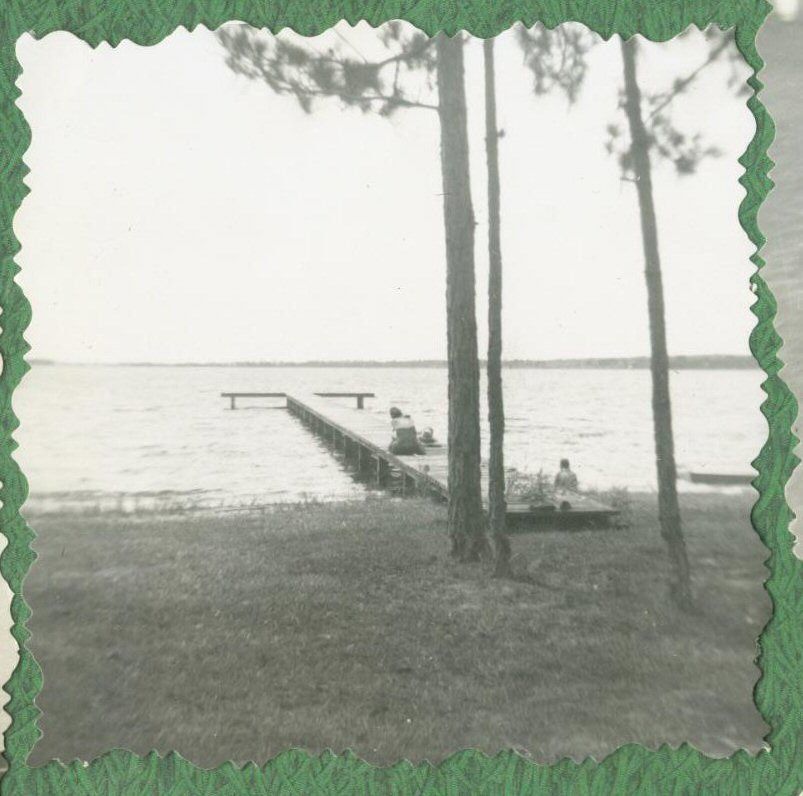
And adults were either at the end of the dock or in lounge chairs on the shore watching the kids and getting their suntans.
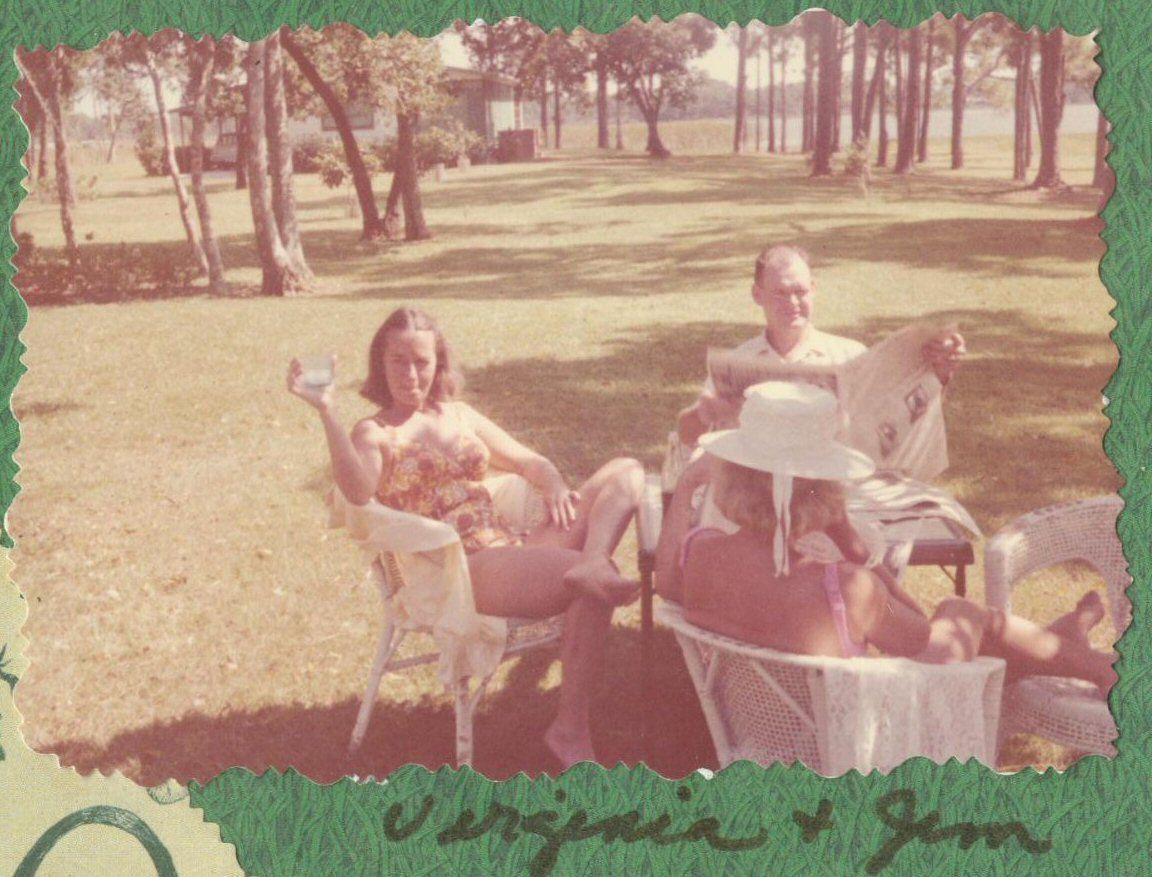
Canoes and inflated tire tubes were central to those activities.
If we weren’t paddling the canoes, we were turning them over and getting underneath into the air pocket or climbing on top of the overturned canoe and playing “king of the mountain”
Late morning or early afternoon found us down at the barns. For Dad it was a time to meet with the farm manager, Bill Osborne (Mr. Osborne to us). Mr. Osborne would also have one or two riding horses ready for us to ride. Occasionally my mother and father and guests also took turns for this farm event.
Sunset found the adults at the end of the dock, sitting in their folding chairs, watching the sunset, drinks in hand.
There might also be another fishing trip as the sun went down.
The night sky was magnificent! It still is today of course but it seems to me, with fewer lights around the cabin and dock and no glow from the town of Lake Placid, that the nights were darker and the stars and moon even more vivid. Maybe just my memory playing tricks?
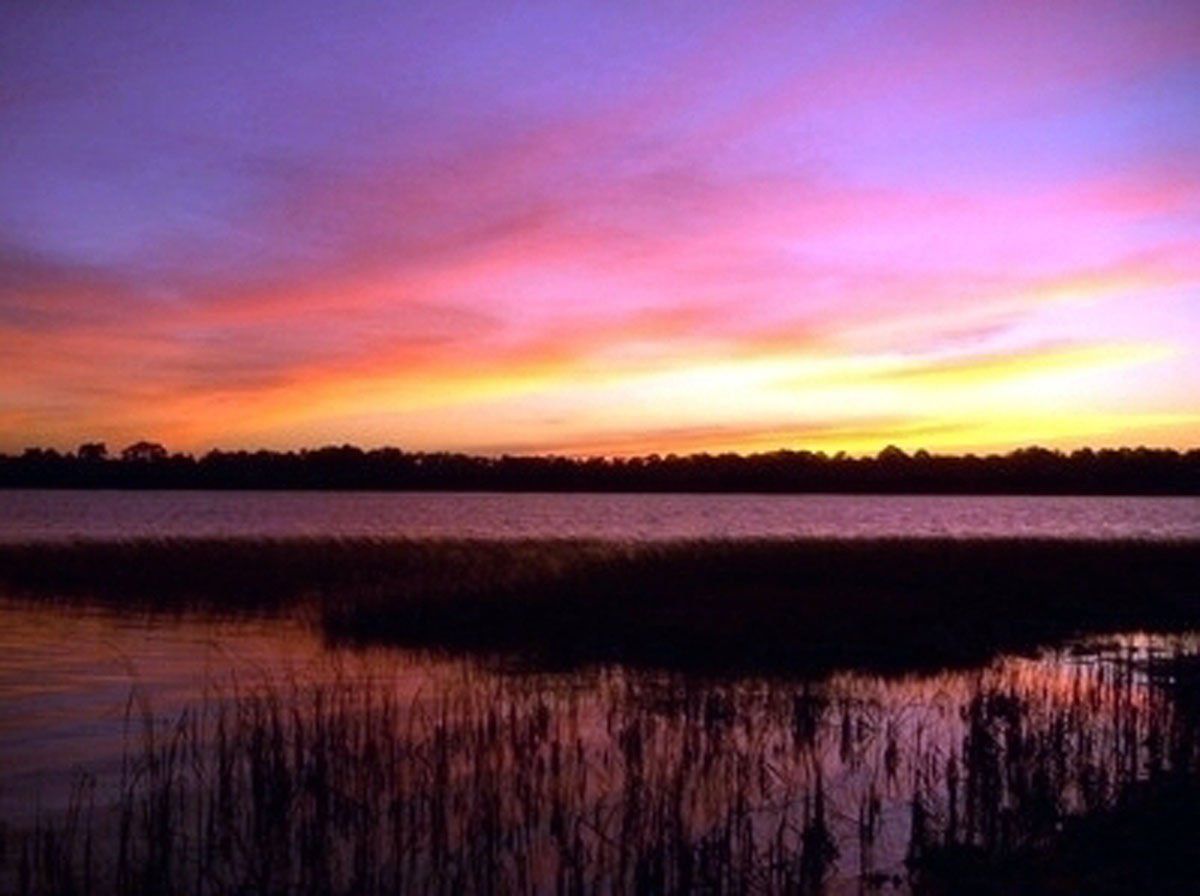
Speaking of the wonders of nature… there were always the alligator, the snakes (water moccasins were the fear back then) an occasional otter, signs of wild hogs, the duck migration in the winter, sand hill cranes, osprey, and an occasional eagle.
Each season was beautiful in itself…. the blazing Summer sun cooled by the ever-present afternoon rain…. Fall signaled with the arrival of migratory birds… Winter, not as much swimming but an opportunity for building a fire in the fireplace … and the beauty of Spring and the blossoming of the magnolias … all a part of God’s country.
Kite flying – especially in the fall and winter - was a favorite activity of mine.
My Dad and I were into model building. I would often have a small gasoline powered model boat to run on the lake. It was a long time before anything remote controlled came along.
Wasps were always a big concern. They were always nesting under the eaves of the houses, but the bigger concern were the nests along the underside of the dock.
It was just something to put up with but then it became more serious.
During the day, when he had the urge, Dad would venture out to the end of the dock with a rod in his hand and cast for bass.
One day he was out there alone and, for some reason, my mother and I and maybe others were on the porch in the main cabin looking toward the lake.
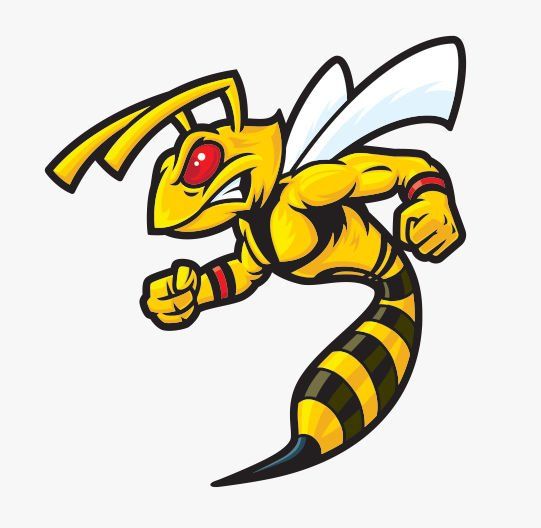
All of a sudden, we saw dad dancing on the end of the dock. It’s a bit far so we couldn’t see the reason for it. My mom thought it was hilarious. I’m sure we were all laughing.
Turns out he had been attacked by a swarm of wasps and was stung a number of times.
He ran back to the house and was treated.
We felt terrible but laughed at the memory of the event for years.
Sunday dawned with a mix of “do everything one more time!” and “get ready for church” and the agony of knowing we would be leaving today.
Church was required L. Good clothes were necessary. And the nearest church was an ancient structure in Sebring. But it was the familiar Catholic mass. Then a long (twenty minutes but long for a ten year old!) drive back to the farm.
Of course, breakfast had been put off – fasting from midnight before communion was mandatory.
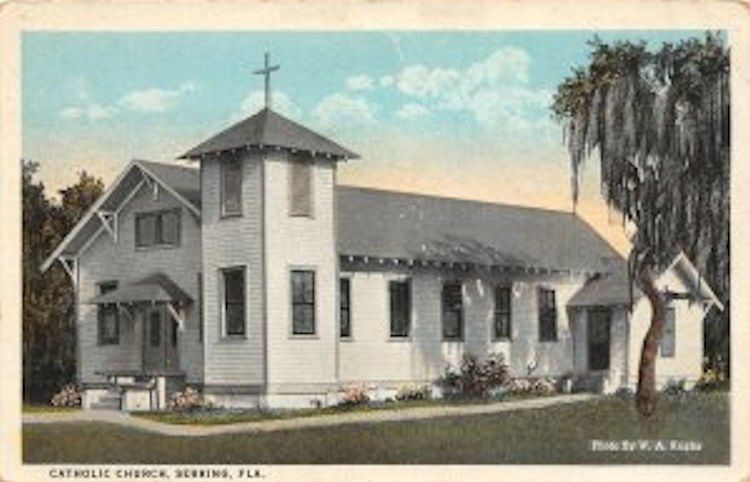
Arriving back to the farm, Mom would make a big breakfast for the second day.
And finally, we could have a little more fun!
Back in the lake… a little more ping-pong …
And then the announcement: “Time to pack up” L.
Then the long trip home, back to school and the long (four weeks?) wait until the next trip to the farm.
The Horse Breeding and Training Operation
The farm today is a retreat for the family. Farming operations are a minor part of Elkcam Farm, kept going mostly to maintain “agriculture status” and the acres of fun it provides.
But in the beginning and through the mid-sixties, the breeding, raising, and training of thoroughbred racehorses was the primary purpose of owning land in Highlands County.
Later, in the 1960s as Ocala emerged as the horse breeding capital of Florida, the Mackle Brothers would buy land there for their breeding operations. Later both Uncle Elliott and Dad each bought land there to raise their thoroughbreds.
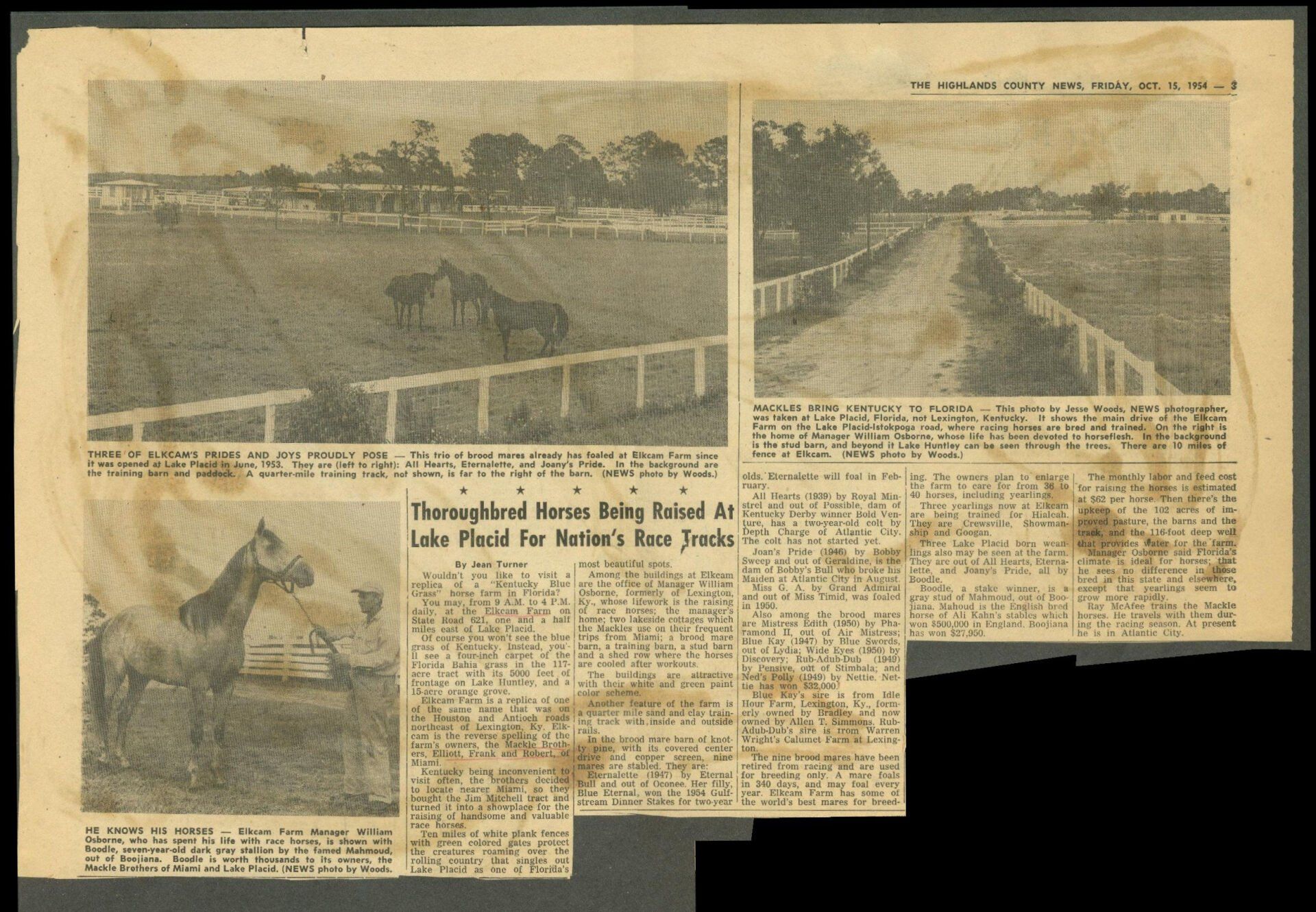
The breeding and raising of racehorses was a serious business or at least a serious hobby for The Mackle Brothers.
From the beginning most of the 115 acres of the Farm was devoted to that business. And, for my father, a main purpose for his weekend there was to see his future “Derby winners” and discuss their development with the farm manager.
In the style of the Kentucky farms, they were familiar with, their Florida farm was enclosed and crisscrossed with white three-rail fencing. Over time, two mare barns, a training or yearling barn and a training track (really, a galloping track) were built. The manager’s home was on the west side of the clay road just north of the stallion barn. Pictures of what looks like a hay barn near the lake south of the training barn also appear in the old videos. Later, on the south-east corner of the property another barn was built.
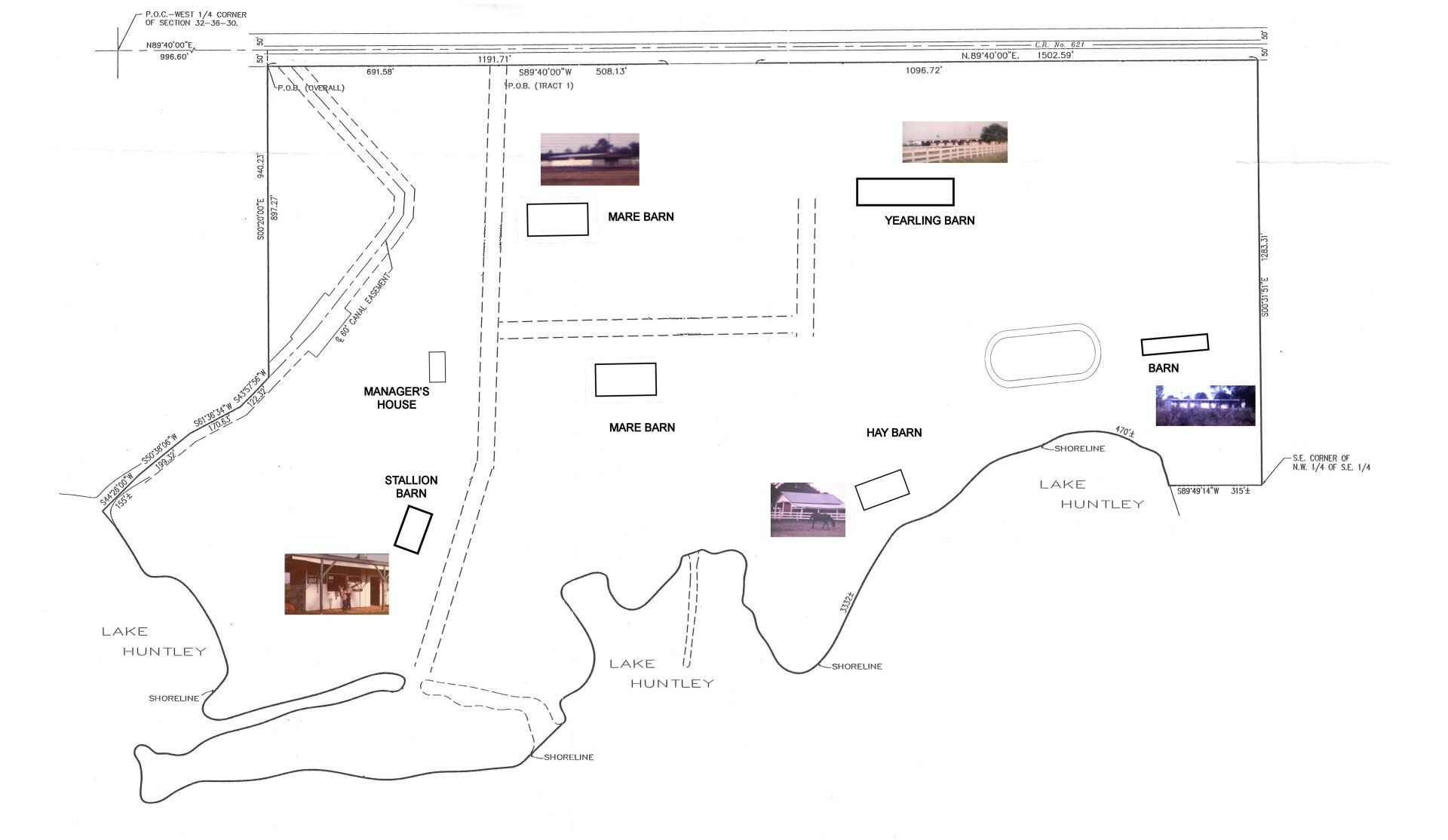
Rough layout of barns in heyday of the breeding operation in the late 50s and early 1960s
A general description of Elkcam Racing Stable operation and history can be read in the Frank E. Mackle Jr. Story – including an answer to the question, “Where did the name Elkcam come from?”. So, I won’t go into it here. But the Farm operation was meant to breed mares, and raise their offspring, break them and prepare their colts and fillies for future glory at the racetrack. They would then be shipped to whatever track the Mackle’s horses were running – usually in the winter or early spring of the year at Tropical Park or Hialeah Racetrack in Miami. At the track these yearlings, now comfortable with saddle and bridle, would be set down to harder training.
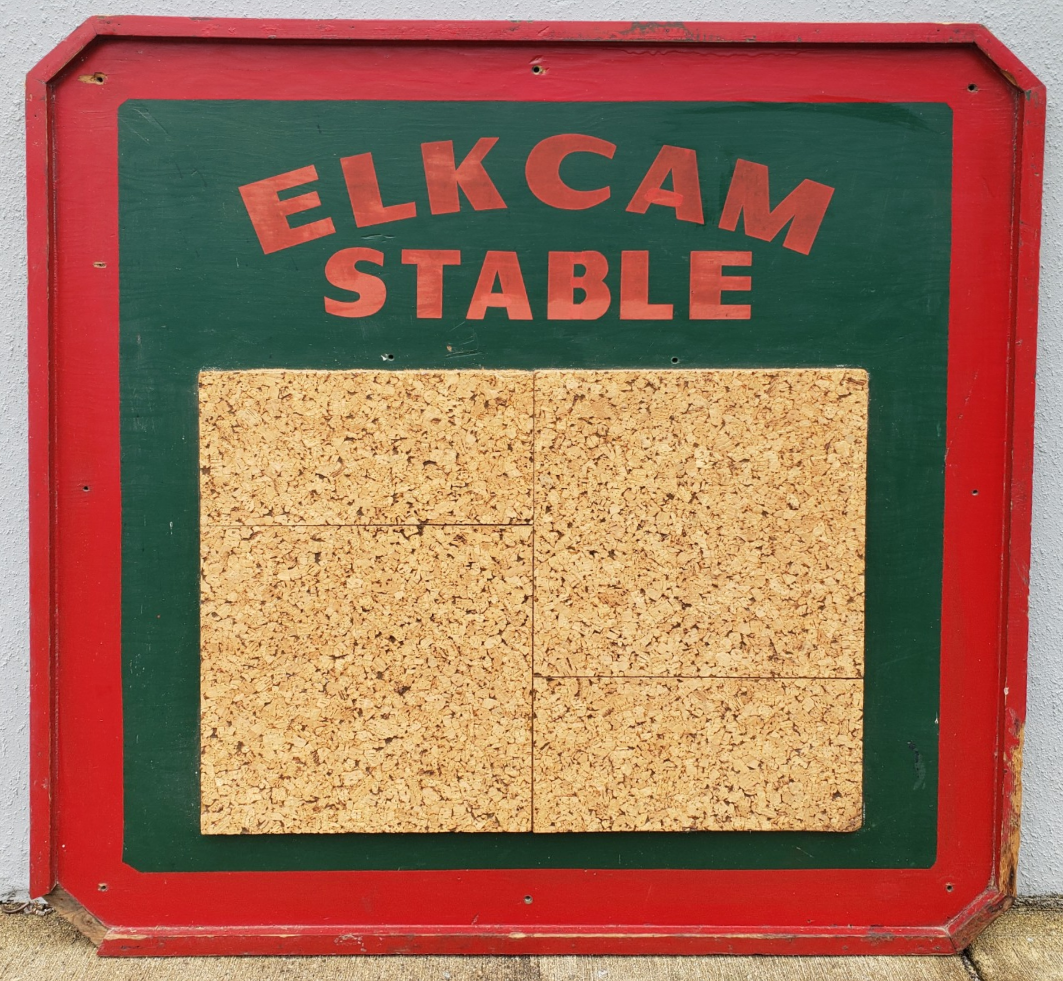
Sign (or one similar) which was a common site at the Farm and the racetrack for 25 to 30 years
For a time in the fifties, there was an effort to promote two stallions for breeding purposes. Boodle, the sire of Hubcap, “stood” there and a stud named Eternal City “stood” there as well. I’m not sure how many, if any, mares, others than owned by The Mackle Brothers, were actually bred to them. A two-stall barn on the main clay road in, far away from the mare barns, was built for our two stallions.
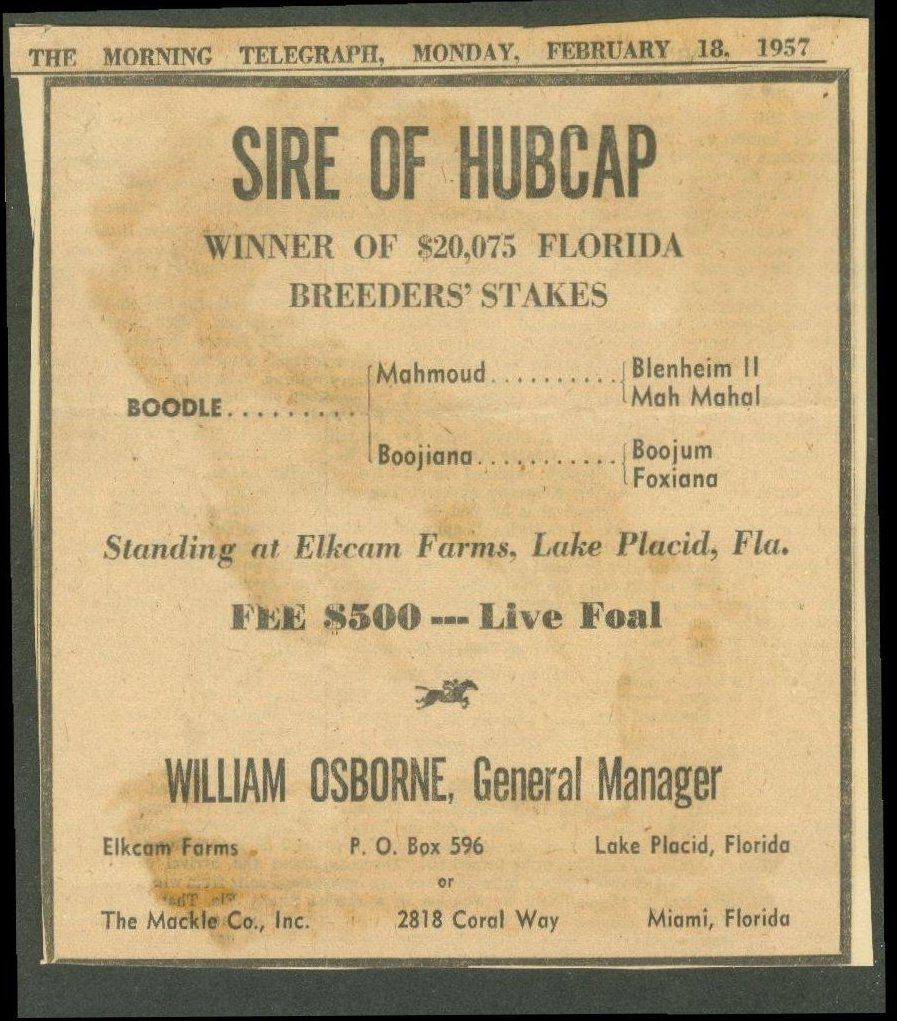
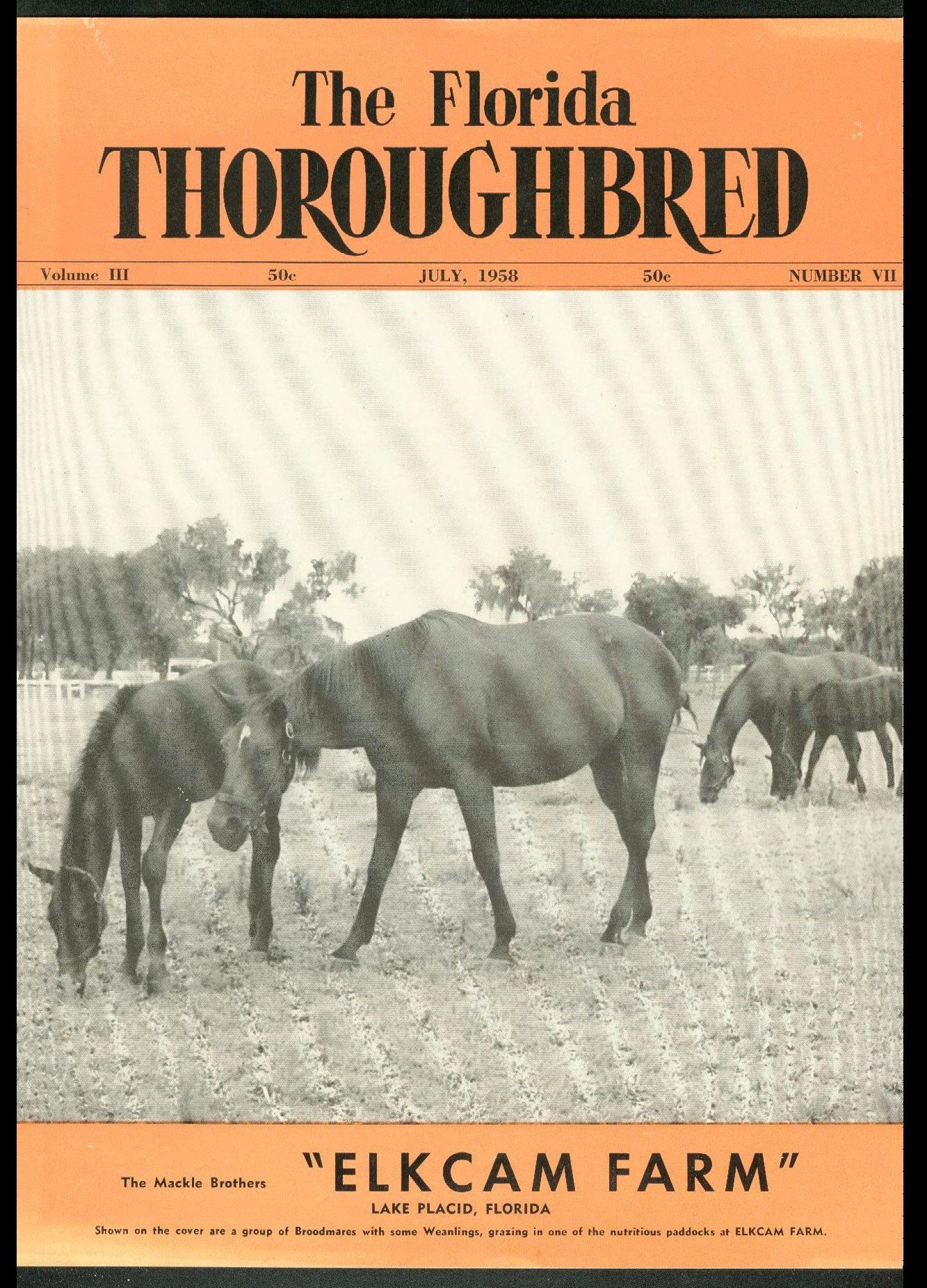
The years 1957,1958 and 1959 saw the pinnacle of the Mackle Brothers success in racing. Hubcap and others had been bred and raised at the Lake Placid Farm. Hubcap won several stake races. Atoll and Open View, purchased in 1958, had won several stake races including the Gotham Stakes in New York and the Derby Trial at Churchill Downs in Kentucky and competed on the 1959 Kentucky Derby.
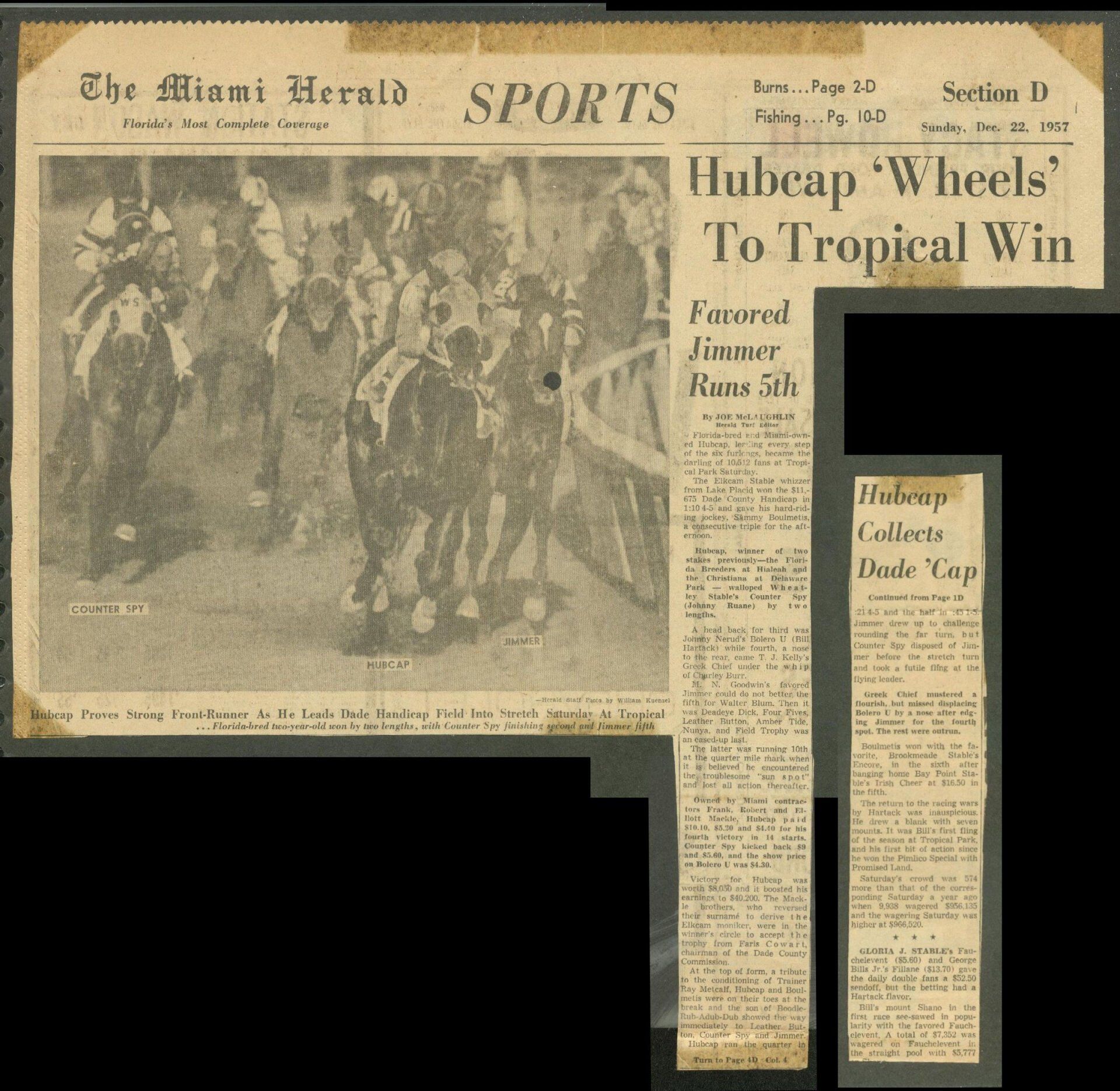
That success encouraged them to “up the ante” on their investment in breeding and racing at Lake Placid.
Around 1960, they purchased a large piece of land a couple miles east of the original property, part of which was on Lake Istokpoga, and built several barns there and – most impressively – a state-of-the-art (I’m guessing seven-furlong to a mile) professional training track there. The idea was to take the training of the yearlings to the next step. When they left the farm they would be track ready and capable of entering races withing a few days or weeks. An assistant trainer was hired as well as a couple of ex or want-to-be jockeys and real race-training began.
In May 1962, when the young two-year-olds were ready to go to the track, the training culminated in a final one-day demonstration of the abilities of the young horses.
And the Mackle Brothers made a show of it!
A “Fair” was announce and advertised locally to come out and seen the event. Small stands were built for dignitaries.
A Few More Stories…
Other Means of Getting to the Farm
I described the usual car trip to the farm.
However, early in the decade we occasionally took the train to and from Sebring. In those days both Seaboard Railroad and the Florida East Coast Railways operated out Miami. We had taken a train several times on our summer trips to New Jersey. On those trips we had a Pullman sleeping compartment.
By the end of the 1950s The Mackle Company, which controlled General Development Corporation (a NYSE traded company), had projects outside of Dade County and had acquired a private plane, a twin-engine Beechcraft seating six passengers. Personal use of the company plane did not phase the Mackle Brother and several times the plane was our means of transport to the farm, taking off from their hanger at Tamiami Airport (now the site of Florida International University) and landing at the Sebring airport.
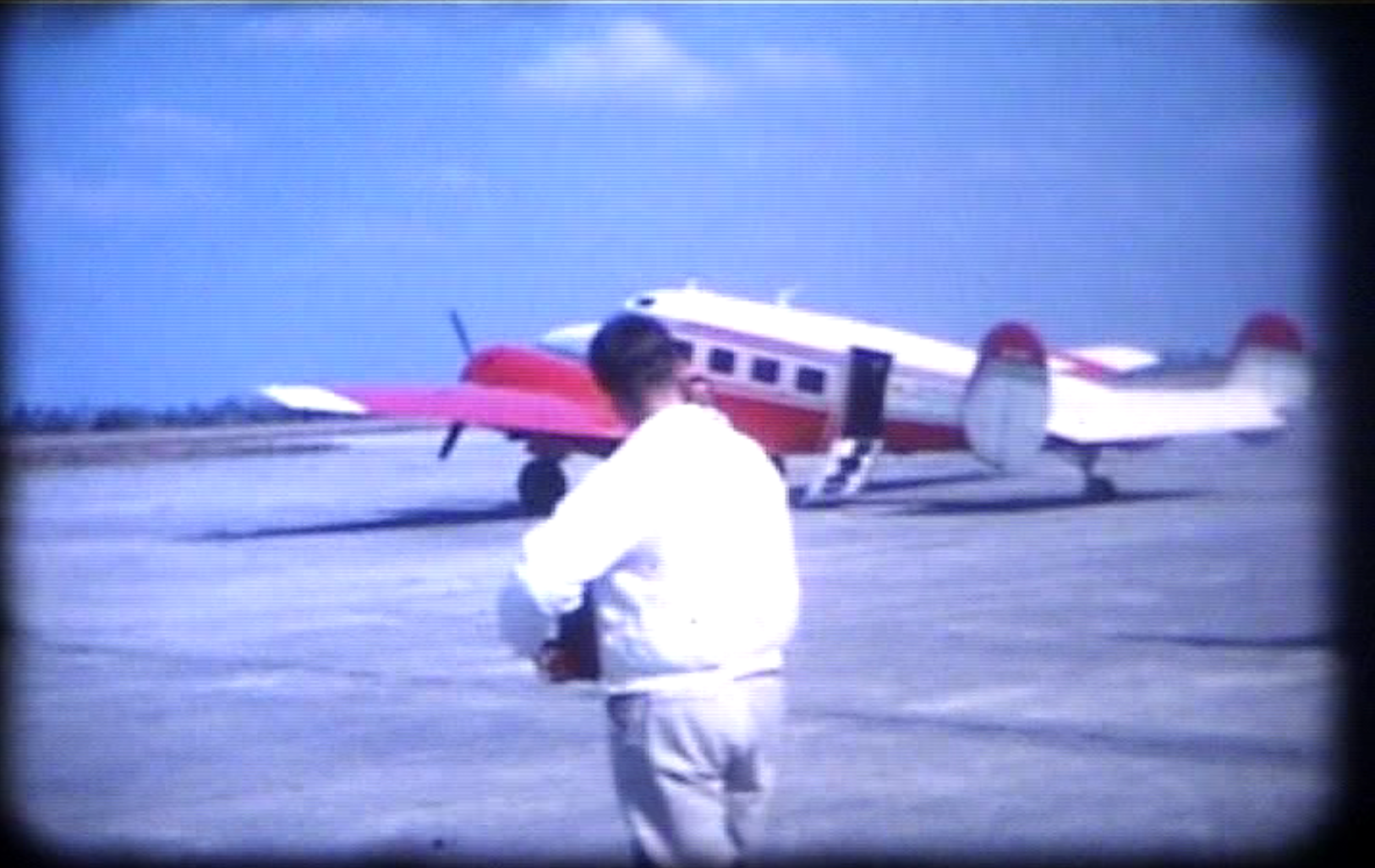
Twin Beechcraft
My Highschool Graduation Party
For the first and maybe the only time I, now eighteen and driving, was allowed to use the Farm by myself. It was in May or June of 1962. My high school friends, Dick Fleming, John Hogenmueller and Manny Mota and I planned a weekend at the farm after graduation from Archbishop Curley Highschool in Miami.
Somehow beer was acquired, and we had a memorable weekend! A few pictures still exist. I only remember the highlights. One of my friends decided he could run a bulldozer. Apparently, some work was being done on the farm and there were a few pieces of heavy equipment parked for the weekend. I can’t remember who it was, but I do remember chasing that bulldozer as he sought a way to stop it, which he finally did without doing any damage!
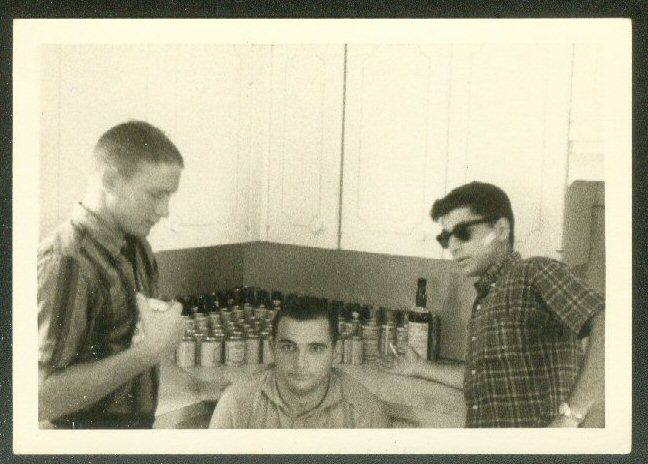
My Buds
Apparently, we were a little bored with only guys on the trip. Somehow, we found out about a high school dance being held at the American Legion Hall in Lake Placid. My memory told me it was on Highway 27 a little north of town and -to my surprise – I found it on-line still there sixty years later. When we arrived, we were amused at the way the girls were in one area and the local guys were in another. We were used to different social behavior in Miami and soon were talking to and dancing with the girls. It wasn’t long before one of the local guys took exception with my red headed friend Dick Fleming (an all-state football player) and quite suddenly a crowd was outside. Dick and this guy were squaring off to fight. Somehow things didn’t go too far. I’m not sure how it broke up but soon we were back at the farm.
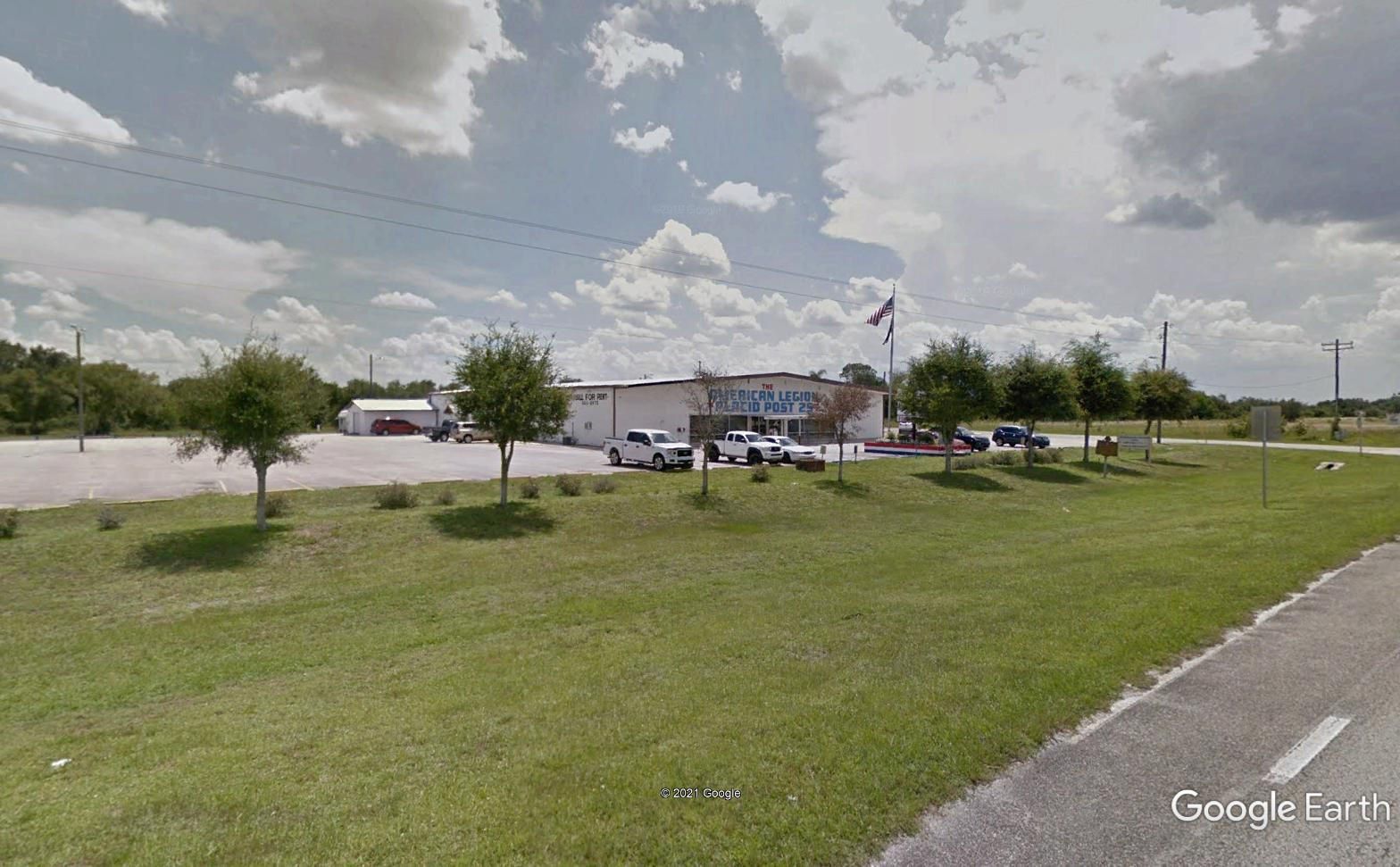
Current picture of the American Legion Hall – still there today.
The Fallout Shelter a.k.a. The Bomb Shelter.
In October 1962 – a month after I left for college – Miamians, including my family, experienced the frightening sights and sounds of the Cuban Missile Crisis. By all accounts, it was not unusual to see armored vehicles traveling south to the Keys to defend against what was feared would be a confrontation with Cuba and the USSR. For a few weeks the three news channels were televising accounts of those anxious times. A lot wasn’t known at the time about how bad it really was and how close we came to war. Years later a book was published, and a movie made called Thirteen Days which told the full story.
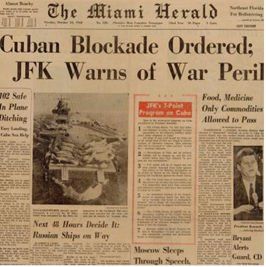
But in 1959 a popular book had been published titled Alas Babylon by Pat Frank. It chronicled the fictional story of a nuclear conflict between the U.S. and the Soviet Union. Interestingly, the story told of a family in South Central Florida who survived the first Soviet nuclear missiles strikes that hit the major cities of Orlando and Miami as well as others in the U.S..
It postulated that the lands between those cities would be spared the worst of the bomb and its radiation because of location and the prevailing winds.
The Mackle Brothers took note!
Soon Mackle Company crews were pouring concrete for a Fallout Shelter with three small rooms and three toilets at the farm near the Main Cabin.
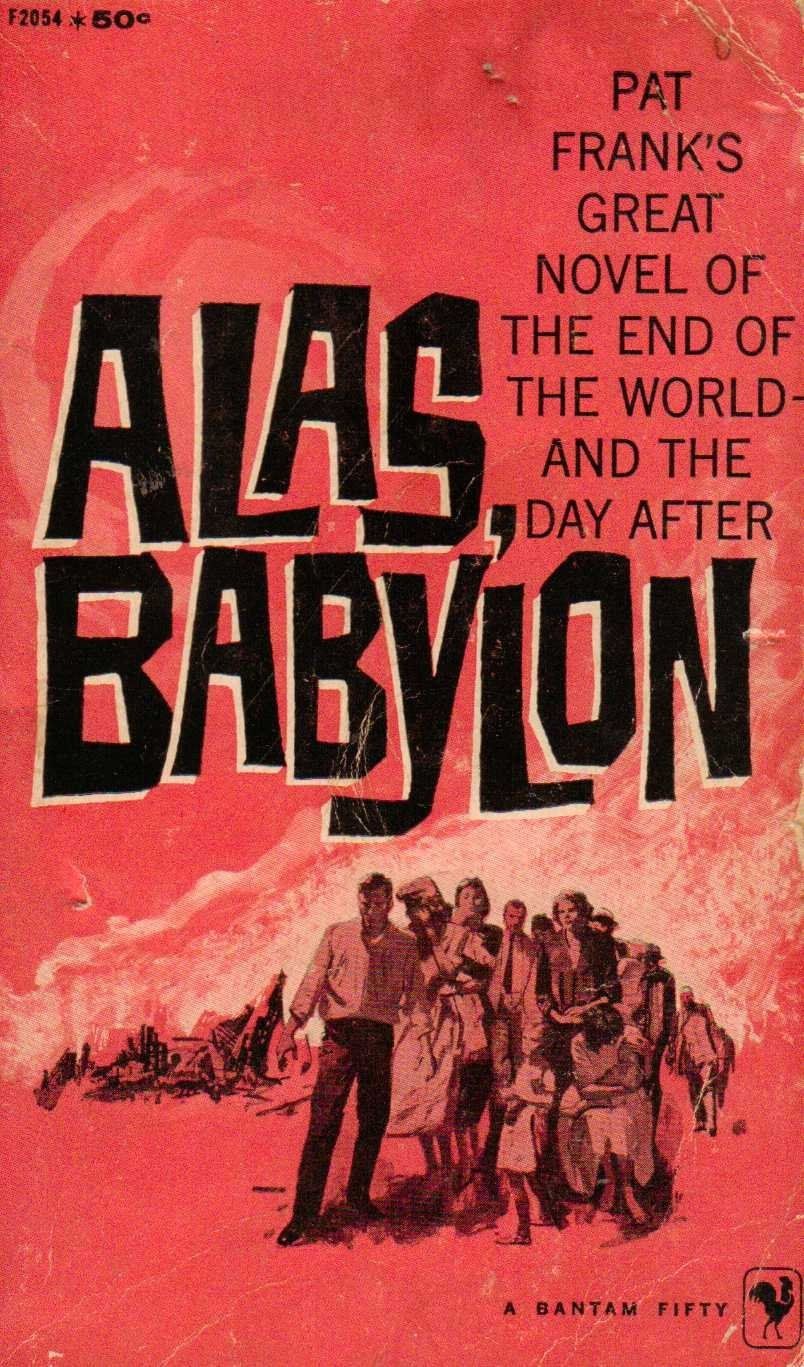
Apparently, they eventually came to their senses as the exterior structure was completed but the interiors were never finished.
Nevertheless, it has survived for almost sixty years now and is a curiosity to this day.

The only purpose it served is to scare children at Halloween. I do remember one early exploration Loretta and I made into the shelter (I’m sure it was her idea) resulted in a cat (was it a wildcat? Panther?J) who was living inside screeching as it flew past us on the way out! I think that was my last time trying to examine the interior.
LIFE Magazine
In February 1959 LIFE Magazine – a leading monthly national publication - featured The Mackle Brothers in a seven-page spread. Their meteoric rise to prominence in the 1950s, developing communities in Florida and selling homes and homesites all over the world brought LIFE Magazine to Miami. Photos were taken at their office, at the racetrack, at their Port Charlotte project, at our home on Miami Beach and elsewhere. Of course, they had to include the Farm. I’m sure it was just a business trip – as I have no memory of being there. But the Farm – and their passion for thoroughbred horses - was included.
THE END OF THE BEGINNING
This first chapter of the story of Elkcam Farm starts to come to an end. In each generation passions for the farm ebbs a bit as children reach their late teens and then leave for college. So, it was with the Mackle Brothers and their children. I left for college in 1962 and Nancy a couple of years later.
Soon it would start over again as a new generation introduced their children to The Farm.
